#for that one character only or alternatively not demeaning the other characters in order to make his blorbo look good
Text
I cannot imagine being a Damian stan right now. You've got both Zdarsky's bullshit (where he clearly doesn't give a shit about your boy) and The Boy Wonder (where Juni Ba clearly gives so many shits about your boy) coming out on the same day. The whiplash must be insane. I hope y'all get some nice warm soup for your efforts jfc
#damian wayne#damian al ghul#damian al ghul wayne#batman#batfamily#for all of the issues that come with having Steph as your fave having too much wild shit happening at once is never one of them#btw I quite like The Boy Wonder Issue 1. wow shocker an artist and writer who I have liked everything they've ever done#has once again written something that I am enjoying with art that makes me want to be part of its world.#it's almost like Juni Ba is really freaking talented or something#like I have some problems with it but it seems like many of those are part of the point. Damian is learning that his siblings are more#three-dimensional than he realized and that is part of this 'coming of age' story merged with fairytale#so I can't be mad at the oversimplistic defining of Dick and Jason and Tim until the conclusion of the series. that might be the point.#I hope that the series will address Steph as a Robin but if not then frankly it's not an issue unique to this series.#I'll be annoyed and disappointed but ultimately roll with it like I am with Babsgirl being here. There's too much good stuff here to get#hung up on shit that seems to be almost an editorial mandate at this point. at least that's where I'm at.#I am also very sorry that Chip Zdarsky is massacring your boy. he has 'X (Tim for him) is the best Robin so everyone else must suck' diseas#where a writer really likes one specific Robin and in trying to uplift them demeans all of the other Robins. instead of like...just writing#for that one character only or alternatively not demeaning the other characters in order to make his blorbo look good#it's wild because I actually think his writing for Tim is pretty solid. but he's not writing a Tim series. he's writing a Batman series.#and if you are going to write a Batman series and include other Batfamily members you need to actually write them well.#instead of assigning them like 2 personality traits while Tim gets to be a whole character#I accept that behavior in fanfic where I have lesser standards because it's fucking free. not a comic run that wants me to pay#tens of dollars in order to understand what the fuck is going on. he's been going for a while now it's gotta be a lot of money.#I can buy Steelworks with that money. I can see John Henry and Natasha Irons in a trade. Fuck you Chip.#it's why it takes such a special person to write a good ensemble story/a good Batfamily story. you have to be good at writing a LOT#of different characters. which I don't think most people are. I sure as hell am not. I can write maybe 3 at a time confidently well.#and you also have to give all of them at least SOME love or else people will be upset that you aren't focusing on their fave#and also the writing as a whole will suffer. Chip Zdarsky is a pretty good Tim writer. I'd maybe read a Tim solo written by him.#I would not read a story focusing on multiple characters that I like written by Chip Zdarsky. because every character who isn't Tim#is at least a bit weak/inconsistent/out of character INCLUDING FUCKING BATMAN. THE NO. 1 GUY MOST ARE HERE FOR
62 notes
·
View notes
Text
This ep of helluva boss was just SO GOOD in terms of propelling Blitzo's character developement forward, especially within the context of the world building of hazbin/heluva canon. Like how Blitzo and Stolas's personalities and their motivations impact their roles in the society they exist in, and by extention, the relationship between the two of them due to the inherent power imbalance of Stolas's status as a royal. Their character arcs both individually and together are shaping up to be extremely interesting! I'll start with a general analysis of both characters and go forward from there.


To start, Stolas is incredibly entitled and definetly suffers from a major superiority complex. It's an interesting contrast to Blitzo's inferiority complex, and to be honest, when you think about it they act as foils to one another in a lot of different respects. While Blitzo is prideful and an incredibly proud individual, there's an underlying note to a lot of his interactions that leaves you with the impression he has a lot of deep seated self-loathing and internalizations of his unloveability (i.e. ep two "does anyone love you blitzo?" "no."); Stolas by comparison, is self aggrandizing and portrays high self esteem and a secure sense of self and what his duty is even while he's in emotional distress (i.e. also in episode two with his lullaby to Octavia when he touches on his disillusionment with love! more on that bit in a sec)

From what I can speculate about Stolas given his portrayal on the show, he appears to be observably shackled to his sense of duty despite the lack of joy it brings him, however he WANTS LOVE. He DESIRES the thrill of that connection. His relationship with Blitzo goes against everything he built his life around (his marriage to Stella, his status as nobility, his responsibilities to safeguard his grimoire) but even despite this he can not help himself. I get the feeling that he may have impulse control issues or perhaps his willingness to just Risk It All speaks to the amount of infatuation he has for Blitzo??? because everytime they are in the same scene, he's just so incredibly elated and constantly vocalizing his desire for Blitzo's presence. He even goes as far to go out of his way to invite Blitzo to things, and introduce him to his daughter! A parent does not do those things lightly- to introduce your child and construct a situation where your 'partner' and your child socialize is a huge deal. On some level, he wants his two favorite people to interact and be introduced to one another, no matter how misguided that is. He did not consider Octavia's feelings or ask if it was what she wanted, only that he had positive memories at Lou Lou Land and he wanted to share that again- this is a show about hell but we've been shown time and time again the humanity and multitudes of emotional depth that the demons in this verse contain. His actions do not make him completely irreprehensible, but instead show that he does indeed have flaws and redeemable qualities despite our first impressions of him at first as a rich fuckboy, and then again as a dorky, well meaning dad with marital issues. His interactions with Blitzo and the other imps of the wrath ring once again recontextualize everything we know about Stolas as a viewer, and I have a feeling this is only the beginning.
Looking at Stolas's lines to Blitzo in episode 5 through the lense of Stolas being an incredibly lonely man (in a presumably, loveless on both sides and open, non-monogamous, arranged marriage), who craves intimacy on an emotional and physical level to the extent that he will extort his assets and risk every facet of his life so that he can have a continuous 'relationship' with someone, I don't think he was intentionally trying to degrade Blitzo (intentionally being the key word here). Which is not to belittle Blitzo's point of view of his experiences with Stolas, as he is totally entitled to how he feels and it stems from a completely valid place based on his socioeconomic standing as an individual in hell. Alternatively though, Stolas is someone born into privilege, therefore he doesn't see how his words come across and how they are percieved by someone in a lower social caste or someone who deals with systematic prejudice. Privilege is having the option to learn about what injustices people suffer because you don't experience them yourself, and that description fits Stolas to a T as it stands.
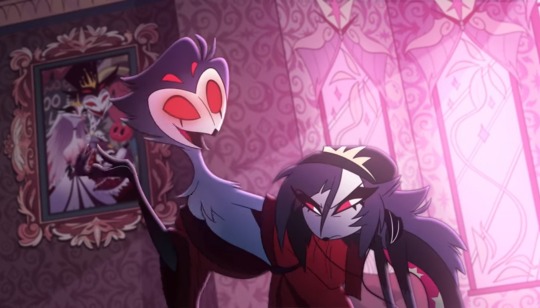

Stolas doesn't understand Blitzo's struggle, and that is the core of their miscommunication on the nature of their relationship. Blitzo won't allow himself to view the relationship as anything other than transactional for fear of getting his hopes up and being vulnerable by showing his hand in an emotional sense, and then being just another imp taken advantage of by someone higher up (if im reading this motif of imps vs the greater hell caste system right). Blitzo has had to fight tooth and nail for every success he's had, every achievement he's had thus far is hard won and it's so easy to diminish your own accomplishments when you're born into a society that makes you have to work 10x as hard as everyone else in order to be treated as an equal to others doing less and still achieving the same and more. To Stolas, his endearments and tendency towards physical affection is an expression of his fondness towards Blitzo, but he doesn't ever consider how those very same actions come across as demeaning/ belittling/ or acts of microagression that disregard his capability.

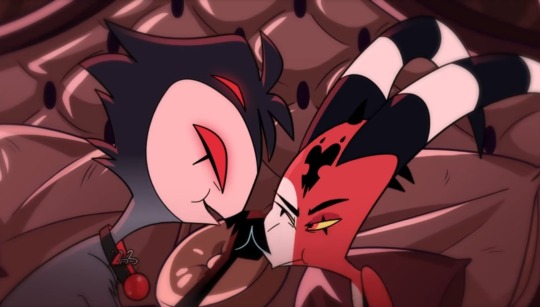

Tldr: im so fascinated by these two bastard demon menaces who have contrasting flavors of intimacy issues and can't wait to see what or who they do next???
2K notes
·
View notes
Text
See and you know... I think the problem with Ooku is that it doesn’t give us an opportunity to understand Kama/Mara’s true motivation until the very end. We don’t get an opportunity to see them dropping the front until they’re at the edge of defeat. And it’s only then that we hear why they did this and like....
When I think about Heaven’s Feel there is an explicit point in the narrative that allows us to see Sakura not as a one sided evil corrupted villain, but as an abuse victim lashing out at others and blindly raging against those who care about her to justify her own self-hatred after years of abuse. I know I mentioned it before but I seriously think the most important scene in HF is when Kirei calls Sakura out and says this isn’t an alternate personality, this is the same Matou Sakura as before who is willingly continuing with her behavior. At that, Sakura is forced to give up the whole unabashedly-evil thing and to start remembering that she’s doing this also because of her immense suffering. She lashes out at Kirei and says he helped make her this way, and it’s from this point on that she really doubles down on her hatred of others who contributed to her abuse (case in point: killing Zouken heartworm right after this).
Why don’t we get the same thing with Kama if they’re going to make the parallels so deep that they literally give them Dark Sakura’s body?
Literally at any point it would’ve been befitting to show that Kama has thoughts and feelings other than “evil seductive depraved apathetic” Literally at any point confronting Kama with a counterpoint of “Is this related to you being burned/becoming the universe” and like, ... I don’t know, even ASKING why they have such a view of love, or rather, who taught them this, who made them feel this way, literally any confrontation of that on an earnest level would’ve rounded out the narrative so much better.
But we don’t get that, and instead, we get Parvati humblebragging about how much of a good person she is, and how Kama’s out of line, and etc. and like. Literally yeah we’re back to square one. Kama is not going to understand self-love if Parvati is going to treat them like this.
I agree that literally Spartacus should’ve been in the story because compassion is literally his driving force in life and his whole existence. Or even honestly anyone other than Parvati because whether you agree w/how Parvati was written or not it was excruciating and aggravating to see this (and excuse me for this) Waifu Character constantly looking down onto a person who they literally KNOW is an abuse victim and demeaning them for not getting better just like... on their own. And scorning them and not even giving them the opportunity to understand what actual mercy looks like. Like, there was no... sympathy or compassion towards Kama at any point.
Ooku would’ve been better written if they had allowed Kama to have a moment of lapsed vulnerability. We would’ve done better if the narrative had spoken about their being blamed for as the god of love or the demon king for wrong doings. Like, halfway through the story we should’ve gotten that info and worked with it.
It just doesn’t do good to show a villain’s motivation or actual sympathetic side (that COULD’VE been addressed) after we’ve defeated them. It leaves you feeling like it’s a hollow victory.
And it particularly rings hollow because the protagonist of Fate/Grand Order is always written in events to be someone who is extremely sympathetic, compassionate, and empathetic even towards villains while showing them a way for them to redeem themselves. Hilariously, we get that in this event with Kiara, but get introduced to Kama as a one-dimensional character up until the last split second...
27 notes
·
View notes
Text
More movies (and a tv series) on youtube to keep you busy
List 1 / List 2
Here’s a third update of movies that you can watch in full on youtube since you’re stuck inside
Documentaries about movies:
Visions of Light: The Art of Cinematography (1992): Featuring interviews with more than two dozen major cinematographers and a ton of clips, this is a useful and enjoyable primer for anyone interested in learning what a DoP does
Vittorio Storaro: Writing With Light (1992): This is a shorter (40 minute) television doc focusing on one specific cinematographer, Vittorio Storaro, famed for his collaborations with Bertolucci and for shooting Hollywood movies like Apocalypse Now and Reds
The Epic That Never Was (1965): In 1937, Josef Von Sternberg started shooting an adaptation of I, Claudius starring Charles Laughton as Claudius. Dirk Boagarde hosts this lively documentary examining why the film was never completed, featuring the surviving footage from the 1937 shoot.
Hollywood: A Celebration of the American Silent Film (1980): Kevin Brownlow and David Gill’s 13-episode miniseries about the silent film era is considered the gold standard for documentaries about film history, but the impossibility of negotiating the rights to all the clips used at a reasonable price has kept it off of dvd or blu-ray. Luckily, that didn’t stop someone from putting it on youtube, although episode 12 has in fact been blocked due to a copyright claim.
Buster Keaton: A Hard Act To Follow (1987) Part 1 / Part 2 / Part 3: Another Kevin Brownlow and David Gill miniseries, this one, as you’ve probably guessed, covers the life and films of Buster Keaton over three episodes.
More movies:
Powell/Pressburger: Michael Powell and Emeric Pressburger, aka the Archers, were one of the greatest writer/director teams in film history (and a favorite of Scorsese, who seemingly made it his life’s mission to ensure that their films were restored and available), and three of their incredibly charming, magical movies are on youtube. Of the available ones, I Know Where I’m Going! is probably the best to start with.
I Know Where I’m Going! (1945): Dave Kehr on the film: “Michael Powell's 1945 film resists easy classification: it opens as a screwball comedy, grows into a mystical, Flaherty-like study of man against the elements, and concludes as a warm romance. Wendy Hiller, in one of the best roles the movies gave her, is a toughened, materialistic young woman on her way to meet her millionaire fiance in the Hebrides; Roger Livesey is the young man she meets when a storm blows up and prevents her crossing to the islands. Funny and stirring, in quite unpredictable ways, with the usual Powellian flair for drawing the universal out of the screamingly eccentric.”
A Canterbury Tale (1944): The Criterion jacket copy: “Michael Powell and Emeric Pressburger’s beloved classic A Canterbury Tale is a profoundly personal journey to Powell’s bucolic birthplace of Kent, England. Set amid the tumult of the Second World War, yet with a rhythm as delicate as a lullaby, the film follows three modern-day incarnations of Chaucer’s pilgrims—a melancholy “landgirl,” a plainspoken American GI, and a resourceful British sergeant—who are waylaid in the English countryside en route to the mythical town and forced to solve a bizarre village crime. Building to a majestic climax that ranks as one of the filmmaking duo’s finest achievements, the dazzling A Canterbury Tale has acquired a following of devotees passionate enough to qualify as pilgrims themselves.”
Gone To Earth (1950): Made under unhappy circumstances (David O. Selznick producing), this is a gorgeous technicolor romance starring Jennifer Jones as a nature loving young woman forced into a choice between two “civilized” men, with tragic results.
Straub/Huillet: If you’re looking for something easy and relaxing to watch during the quarantine, I’d recommend literally anything else other than the films of Jean-Marie Straub and Danièle Huillet. J. Hoberman on the couple: “Straub-Huillet, as they preferred to be called, are cinema’s conscience — an antidote to all the junk movies you’ve ever seen. Drawing on Kafka, Cézanne, Brecht, Schoenberg and Malraux, to name only some of their best-known sources, Straub-Huillet films are meant to raise ethical questions on subjects as varied as proper camera placement and the appropriate political approach to the subject.“We make our films so that audiences can walk out of them,” Mr. Straub once said, perhaps not altogether in jest.” Of the available ones, Class Relations, their adaptation of Kafka’s unfinished novel Amerika, seems to be agreed upon as the easiest place to start as it’s the closest to a straightforward narrative, although History Lessons has also been recommended as a relatively easy starting place by some people. Not Reconciled, which compresses an epic Heinrich Boll novel following three generations throughout multiple timelines into 52-minutes, is not recommended to start with. MUBI did a retrospective of their works and had essays commissioned for each one to help viewers out so I’ll link those with each film. Hit Closed Captions for subtitles.
Not Reconciled (1965): Here’s a 10-minute video essay by critic Richard Brody that will help you have a slightly easier time with Not Reconciled if you decide to give it a try. Here’s the MUBI essay
Othon (1970): In the 17th century Pierre Corneille wrote Othon, set in ancient Rome. Straub-Huillet’s adaptation is shot in the actual ruins of Roman palaces with modern buildings and cars visible in the background. The MUBI essay
History Lessons (1972): An adaptation of Bertolt Brecht’s The Business Affairs of Julius Caesar. From the MUBI essay: “In the film, an unnamed young man tours Rome and conducts interviews with toga-clad members of ancient Roman society on the subject of “C,” meaning of course Julius Caesar. It plays like Citizen Kane shorn of any of the flashbacks that bulk out that film: here, it is all exposition, reminisces, impressions. Interspersed through these sedentary discussions are a series of randomly protracted car rides through the city, all recorded in unbroken takes from the backseat of the young man’s Fiat 500.From this brief description alone, I’m sure you can see why structuralist-minded academics in the seventies had a field day.“
Fortini/Canti (1976): From the MUBI essay: “In Fortini/Canti, the Italian Communist writer Franco Fortini reads aloud from his Dogs of the Sinai (only recently translated into English for the first time), a memoir of his life as an Italian Jew and an extended reflection on the aftermath of the Third Arab–Israeli War of 1967 and its representation in the Italian media and by the political class. [...] Like all of Straub-Huillet’s movies, this astonishingly combative film follows an internal rhythm born out of the particulars of landscape, of speech, and of the physiognomies of its actors. It begins with an extended recording of a television newscast about Israel/Palestine (thus distancing the audience from the warped words and images on screen), a quotation from Fortini that connects like a punch in the jaw (“People don’t like having to change their minds. When they have to, they do so in secret. The certainty of having been tricked turns into cynicism. Gain for the cause of conservatism”), and then alternates between short jabs like these and more sustained verbal and visual attacks.”
Too Early/Too Late (1982): Serge Daney on the film: “No actors, not even characters. If there is an actor in TOO EARLY, TOO LATE, it’s the landscape. This actor has a text to recite: History, of which it is the living witness. The actor performs with a certain amount of talent: the cloud that passes, a breaking loose of birds, a break in the clouds; this is what the landscape’s performance consists of. This kind of performing is meteorological. One hasn’t seen anything like it for quite some time. Since the silent period, to be precise.” The MUBI essay
Class Relations (1984): The aforementioned adaptation of Kafka’s Amerika, often recommended as a place to start with Straub/Huillet. The MUBI essay
Hitchcock: Back to fun stuff, three Hitchcock classics.
The 39 Steps (1935): Dave Kehr: “As an artist, Alfred Hitchcock surpassed this early achievement many times in his career, but for sheer entertainment value it still stands in the forefront of his work.“
Shadow of a Doubt (1943): Kehr again: “Alfred Hitchcock’s first indisputable masterpiece. . . . Hitchcock’s discovery of darkness within the heart of small-town America remains one of his most harrowing films, a peek behind the facade of security that reveals loneliness, despair, and death. Thornton Wilder collaborated on the script; it’s Our Town turned inside out.“
Spellbound (1945): No one would argue it’s Hitchcock’s best and the psychoanalysis is very dated but with Gregory Peck, Ingrid Bergman, and Dali-designed dream sequences there’s still enjoyment to be had.
Ozu: One of Japan’s most beloved and revered filmmakers, he’s primarily known for his post-WWII family dramas, but his career stretched back to the silent era (although most of his silent films are lost). I Was Born But... is a good place to start but it’s not representative of the style he’s known for. Late Spring is where his later style fully emerges, and it’s a good place to start, so you might want to go in chronological order with these (Tokyo Story, widely considered one of the greatest films of all time, is also not a bad place to start).
I Was Born But... (1932): Jonathan Rosenbaum on the film: “One of Yasujiro Ozu's most sublime films, this late Japanese silent describes the tragicomic disillusionment of two middle-class boys who see their father demean himself by groveling in front of his employer; it starts off as a hilarious comedy and gradually becomes darker. Ozu's understanding of his characters and their social milieu is so profound and his visual style—which was much less austere and more obviously expressive during his silent period—so compelling that the film carries one along more dynamically than many of the director's sound classics. Though regarded in Japan mainly as a conservative director, Ozu was a trenchant social critic throughout his career, and the devastating understanding of social context that he shows here is full of radical implications.“
The Only Son (1936): Criterion’s jacket copy: “Yasujiro Ozu’s first talkie, the uncommonly poignant The Only Son is among the Japanese director’s greatest works. In its simple story about a good-natured mother who gives up everything to ensure her son’s education and future, Ozu touches on universal themes of sacrifice, family, love, and disappointment. Spanning many years, The Only Son is a family portrait in miniature, shot and edited with its maker’s customary exquisite control.”
Late Spring (1949): Ignatiy Vishnevetsky: “Each shot in Late Spring is striking on its own; the mature Ozu belongs to that rare category of filmmakers whose work can be recognized from a single frame. But together—with all their abrupt shifts in visual perspective and time—they become a mosaic, deeply poignant and ultimately mysterious in the way it envisions a relationship between two people trapped by how much they care for one another. There are domestic dramas, and then there’s this.“
Tokyo Story (1953): Dave Kehr: “The film that introduced Yasujiro Ozu, one of Japan's greatest filmmakers, to American audiences (1953). The camera remains stationary throughout this delicate study of conflicting generations in a modern Japanese family, save for one heartbreaking moment when Ozu tracks around a corner to discover the grandparents, alone and forgotten. A masterpiece, minimalist cinema at its finest and most complex.“
Early Spring (1956): Ozu on the film: “I wanted to portray the life of a white-collar man — his happiness over graduating and becoming a member of society. His hopes for the future when he got his job have gradually dissolved and he realizes that, even though he has worked for years, he has accomplished nothing worth talking about. By delineating his life over a period of time, I wanted to portray what you might call the pathos of the white-collar life...I tried to avoid anything that would be dramatic and to accumulate only casual scenes of everyday life in hopes that the audience would feel the sadness of that kind of life”
Equinox Flower (1958): Vincent Canby: “One of Ozu's least dark comedies, which is not to say that it's carefree, but, rather, that it's gentle and amused in the way that it acknowledges time's passage, the changing of values and the adjustments that must be made between generations.“
Late Autumn (1960): Peter Bradshaw: “Another gem from the Ozu canon, a masterpiece of tendernesss and serio-comic charm, as tonally ambiguous and morally complex as anything he ever made.“
And the tv series:
The Armando Iannucci Shows: You may know Armando Iannucci from his films, In The Loop and The Death of Stalin, or from some of his other television shows like The Thick of It or Veep, or from his involvement in all the Alan Partridge series with Steve Coogan. You probably missed The Armando Iannucci shows, his stream of consciousness sketch comedy that ran for one season back in 2001 (it didn’t help that it debuted in September of 2001), but it’s probably the most purely funny thing he’s ever done.
372 notes
·
View notes
Text

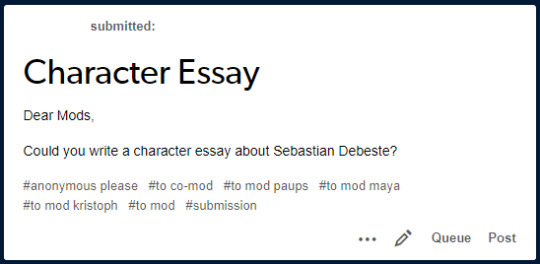
Dear askrikkaiandhyotei and Anonymous,
Absolutely! Because for you, I know only Debeste will do.
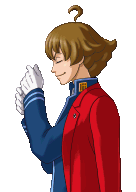
Sorry, I couldn’t resist.
Sebastian Debeste is the sort of character who can be instantly recognized -- his proud smile, punctuation mark hairdo, Themis Legal Academy uniform, cape-like red coat, and conductor’s baton announce his presence before he has to say a word.
That doesn’t stop him from speaking, of course.

His manner of speech is another strong characteristic -- he loves to talk about himself proudly and dramatically. If it was his life goal to be an actor, he’d be well on his way, but it turns out he’s an aspiring new prosecutor, well on his way to become “The Best”...or so he thinks.
This brings us to yet another outstanding trait -- his tendency to get even basic things wrong, from case information to simple idioms.

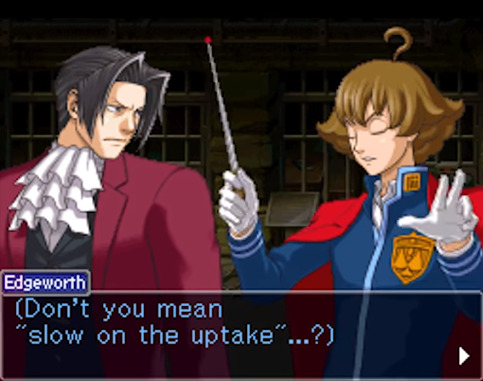
You’ve have to love the irony in that mistake, don’t you?
His authoritative-but-naive attitude is pretty adorable at first, plus it makes it easier for Edgeworth to win arguments against him. His cockiness even opens the door for Edgeworth to continue investigating.
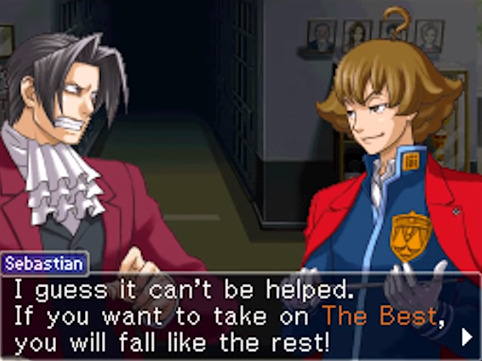
But it turns out he’s not in quite the same category as your run-of-the-mill Ace Attorney prosecutor (cocky, self-righteous, and demeaning). No, the main reason for his behavior is that he wants to be seen as a culpable capable prosecutor by those around him -- his mentor, Justine, his fellow prosecutors, and of course, his dear old Pops. Who wouldn’t have this as a career goal, especially as a rookie?
With that in mind, it’s not so fun to see him goof up at every other thing he tries to do.

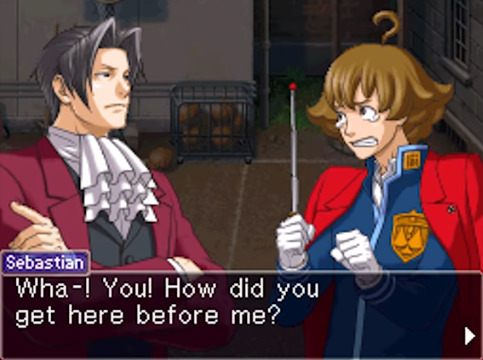
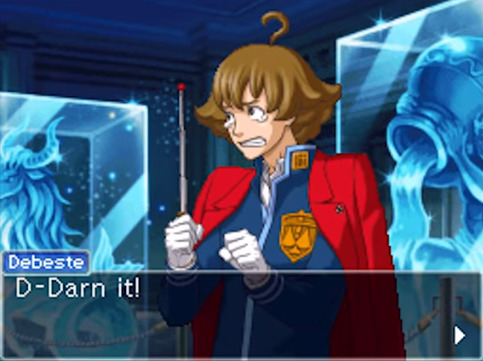
...Okay, maybe a little.
Sure, it’s mostly his own negligence that’s to blame, but you definitely can’t blame him for a lack of enthusiasm. Even sadder than this, though, is his main reason for wanting to be a prosecutor.
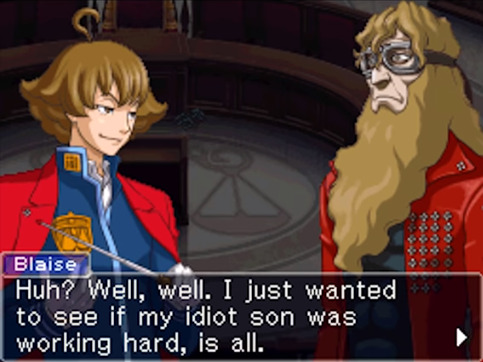

Now, there’s a good question.
It’d be one thing if his father, whom he reveres as both a parent and a career role model, were to point out his clumsiness, and perhaps offer some correction, the way Edgeworth often does with Gumshoe. Instead, though, he publicly disdains him, even calling him an idiot. Thankfully, this doesn’t do much to discourage him from trying his best (in fact, it gives him another reason to prove himself as a capable prosecutor), and he’s lucky enough to have someone like Justine to provide the encouragement his father denies him.

The real tragedy, however, occurs when he learns (as we do) the ugly truth behind his role model.
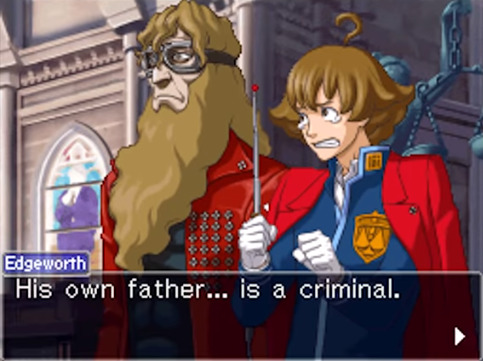
As often happens in the Ace Attorney series (and in real life), arriving at the truth isn’t always pleasant, as poor Sebastian learns during Edgeworth’s P.I.C. hearing. Not surprisingly, the thought of his father and role model being a criminal turns his world upside down.
And as if hearing the truth about his father wasn’t bad enough, he also learns a few unpleasant things about himself.
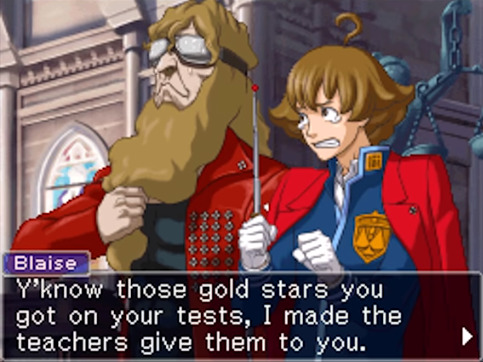

One by one, Sebastian’s accolades become entirely worthless, and whatever efforts he made to earn them are instantly rendered meaningless. Even if he were twice as old as he is, I wouldn’t blame him for what he does next.
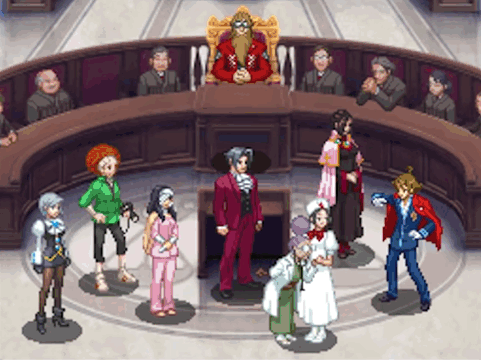
Like a kid who just got bullied, he runs off crying. At least it can’t get any worse than that, right?

Obviously, it can.
Soon after that ugly scene at the P.I.C. meeting, he finds himself caught up in another case, and in need of rescuing. It’s comforting to know he isn’t the only Debeste who goofs up, but now it looks like he’s hit rock bottom, both in his profession and in his self-confidence.
This brings me to the part that, as I mentioned once before, is the one moment in the entire Ace Attorney series that made me cry. I’ve never been so unfortunate as to be kidnapped or belittled by a parent, but like Sebastian, I know the sting of realizing you don’t know near as much about your field of study as you thought you did. In fact, I honestly wondered what he could do at this point, or what I would do in his position.
Thankfully, as fate would have it, he has a wise and caring prosecutor there to pull him out from the ditch he’s fallen into.
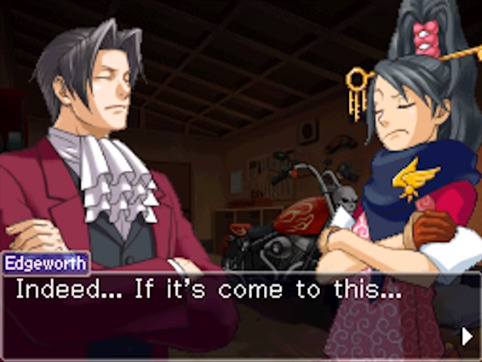

Unlike one of Edgeworth’s usual Logic Chess sessions, where his only goal is to lure the truth out of someone, he also uses this one to help out an emotionally traumatized Sebastian. In fact, it could easily be compared to one of Athena’s therapy sessions.

It’s sad enough to see a prosecutor cry, but now his tears are even more bitter (and frequent). Luckily, Edgeworth’s strategy of waiting patiently for his opponent, or in this case his temporary pupil, gradually helps Sebastian come out of his shell and answer the questions he’s been left to figure out, the biggest one being...
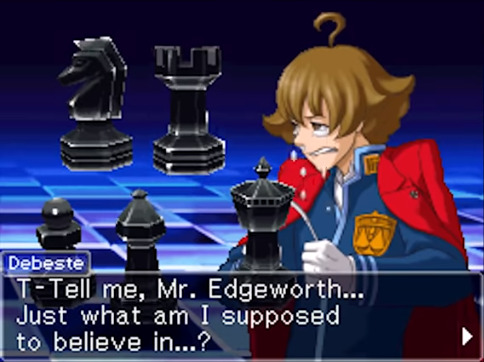
While Edgeworth can’t give him experience, he does offer him some very helpful wisdom:
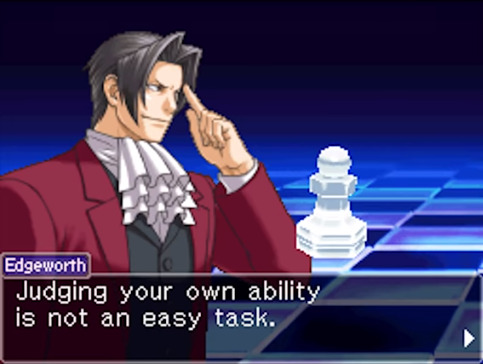
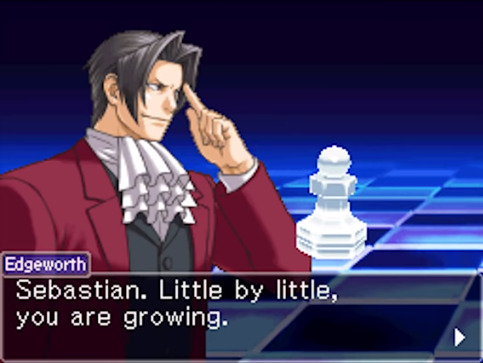
As the conversation goes on, Edgeworth helps him build up the courage to face the truth about his father, to begin living his own life, and to face the greatest trial of his career, so to speak. Most importantly, though, he gives him a lesson his father never bothered to teach him:

And in one of the most beautiful checkmates there ever was, Edgeworth sets Sebastian up, not only to be a capable prosecutor, but to be a better one than his father. Not to mention, he even helps him fix some of his malapropisms! Have you ever considered being a career counselor on the side, Edgeworth?
So, where does Sebastian go from there? He mostly disappears from the scene until Edgeworth and company’s final confrontation with Blaise and Patricia, where he somehow (i.e. through the magic of Ace Attorney timing) shows up with crucial evidence in the nick of time, similarly to what Franziska once did in one of Phoenix’s trials. As soon as he walks in, he’s faced with his biggest fear -- his former role model.
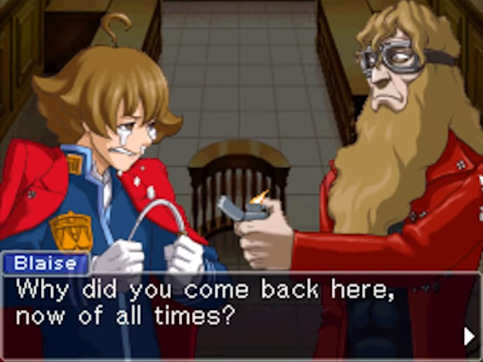
Not to mention an angry prosecutor who took his place after he abandoned his post.

The Sebastian we’ve saw before would probably walk away with his tail between his legs, but the one we’re seeing now?
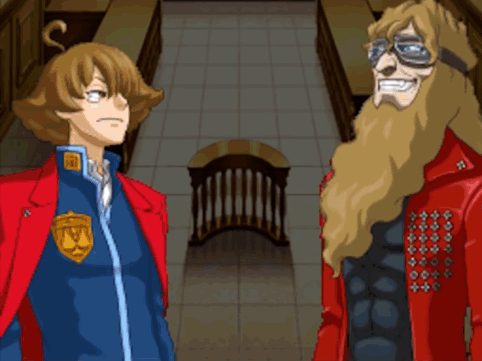
In the next moment, Sebastian demonstrates in his face, his words, and an aura of courage, just who he is now -- not the “sniveling child” his father expects him to be, but a man who’s ready to accept his responsibilities as a capable prosecutor. Even Edgeworth didn’t see his transformation coming.
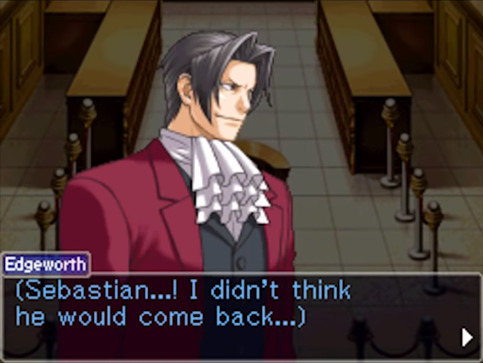
Discovering himself wasn’t the only thing Sebastian was doing, though. While Edgeworth and the gang were busy with their own investigations, he was hastily searching the garbage dump for the evidence his father threw away. His efforts to find it were fruitless, but he didn’t come up completely empty-handed.
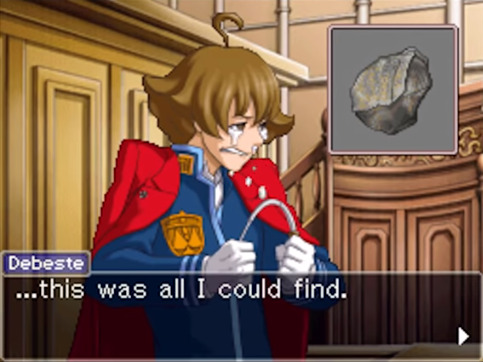
It seems like a dead end at first, but with Edgeworth’s help, he converts a piece of garbage into the key to finally exposing Patricia and his father for the “stinking” criminals they are. Naturally, facing and prosecuting his own father takes a little encouragement from Edgeworth...

...but he works up the courage not only to face the truth, but to say goodbye to the one person he’s depended on, in a bold yet bittersweet fashion.

Something like that really does require The Best kind of person.
So, when it comes to character development, something Ace Attorney does beautifully every time, Sebastian Debeste serves as a shining example of a transformation from a bold, naive child riding his father’s coattails to a man who, unlike Blaise, who believes being The Best means being heartless, pursues justice over personal gain. By the end of his story, he’s still somewhat unsure of himself, but at least his ambitions are a bit more reasonable this time around.
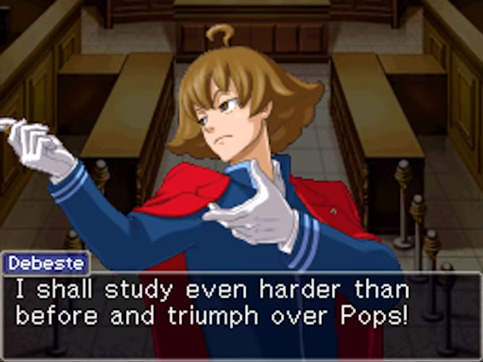
And with people like Edgeworth, Justine, and Uncle Ray around to show him the way, he's more prepared than ever to achieving that dream.
And of course we can’t leave out his unique hairdo. The question mark shape could be seen as a symbol of confusion or lack of knowledge, while the transition to an exclamation point when he learns something new symbolizes a moment of clarity. Alternatively, the question mark could be seen as his curiosity for learning new things, while the exclamation point symbolizes the learning process. In either case, Sebastian’s story illustrates an important life lesson for anyone -- namely, that you don’t have to be The Best in order to keep learning.
-The Co-Mod
99 notes
·
View notes
Text
Once Upon a Body Swap!
At first I thought this episode would be filler, and I was honestly all for it! Sometimes, regular slice-of-life shows without overarching plot points are good (although my love for the latter still remains)! And just about every episode we’ve gotten so far has been relevant to the plot and characters in its own way!
However, THEN Luz-as-Eda got arrested, and we got Lilith! I was excited to see her and just in general I keep thinking about her and Eda’s complex relationship, and it shows!
The last time we saw Lilith, she said that Eda’s days were ‘numbered’. At first glance this sounds like typical, ominous bad guy words. But really, if you take into account how Eda’s curse works and so forth... Really, it can be interpreted less as “I’ll get my revenge on you Eda!” and more “Eda, time is running out from this curse and if you don’t get help ASAP, things could turn out VERY wrong.”
And this episode basically proved me right! I was hoping for at least a mention of Warden Wrath when the Conformatorium was brought up, but then Lilith came in and showed us why she’s such an interesting character. She makes a big deal to Kikimora about how she’ll ‘capture’ Eda... But as soon as she has her chance, she immediately goes out of her way to grant Eda amnesty.
Obviously, it’s with a catch- She HAS to join the Emperor’s Coven. But Lilith doesn’t exactly frame it as “I do this and in return you do this”, she genuinely thinks the Emperor’s Coven is a good opportunity for Eda! And from the way she’s so excited to be with her sister, it really shows that she cares a LOT and has always been looking the other way, if not outright interfering, in order to keep Eda safe.
That being said, she does talk about Eda “no longer being a threat to society” or something like that, which... Yikes. Lilith means well but she can also come across as harsh and condescending. I wouldn’t be surprised if these sort of casual, off-handed remarks genuinely hurt Eda back when they were younger. Eda knows Lilith means well, but there’s probably this idea that Lilith still views Eda as a ‘problem’ to be fixed. Eda just wants to be treated with respect as a person, and I wouldn’t be shocked if her getting cursed led to discrimination and her falling out with ‘society’ as a result. Alternatively, Eda’s moral sense and belief in freedom was also what led her to rejecting the Emperor’s Coven. Either way, Lilith is making an effort but she also doesn’t seem to understand what Eda’s going through as well.
On the flip-side, I know that I keep appreciating how Lilith will always look out for her sister by the end of the day... But her rant at the end indicates some growing frustration. There may come a point where Eda’s rebukes cause Lilith to just snap and decide that, NO, she’s going to forcibly bring Eda along into the Emperor’s Coven so her sister can be safe and happy and accepted, and hopefully they can cure the curse! And, if we want to consider the potential parallels between Lilith and her protege Amity... I wonder if Eda herself was cruel to Lilith when they were younger? It could be a complex relationship of Eda always making Lilith feel ashamed and embarrassed, especially after becoming cursed and a criminal. But on the other hand, Lilith is no saint with how she ultimately still ‘others’ Eda in her attempts to reach out.
There’s this sense that the sisters both care for one another... But they’ve also got a lot of growing issues and insecurities that keep them from quite bridging the gap. They have different beliefs, different experiences, etc., and it’s possibly getting harder and harder for the two to reconcile.
(Sorry, I just... have a lot of feelings about Eda and Lilith. Lilith wants the best for Eda but she’s also a bit insensitive and willing to steamroll over what her sister has to say, dismissing Eda’s valid issues with the system and assuming the system will fix everything. Likewise, Eda may or may not be guilty of treating Lilith like a joke, pushing her away, and not taking her seriously. I just love them.)
Now, with THAT part of the episode out of the way...
I really appreciate the decisions for who switched with whose body in each scenario! Arguably, it’s like the main trio walked in the shoes of the one they sort of ‘knew the least’ in their own sense.
Take for example, Luz becoming Eda. Now, Luz already knows King, she frequently acknowledges the limitations of his stature, and has heard about his insecurities with being taken seriously, about wanting others to know more about demons, etc. The two are close.
Luz and Eda, however... Again, they’re close. But as the show itself teases, there’s really a lot Luz doesn’t know about Eda. She’s curious about Eda’s past, she wants to know more about magic and how Eda does it, and so forth. Eda’s admittedly a bit more prickly with Luz, unlike King.
Next, we’ve got King. King doesn’t need to walk in Eda’s shoes, he’s been with her longer than Luz and is a fellow fugitive. They’ve run from the law together, fought together, and were willing to go down together as early as episode 1. They clearly have a past and King knows what it’s like to be on the run, no questions there.
I mentioned earlier that King and Luz are definitely closer than Eda and Luz... But amidst it all, it’s important to remember that unlike Eda, he has very little understanding of growing up as a young teen, having the pressure of being bullied and ostracized, and so forth. Granted, King’s past is a bit of a mystery, but from the way he talks he’s never been in a typical school setting with other peers his age. He also doesn’t take her teenage problems seriously, because to him, Luz has had it easy and hasn’t quite lived on the run as a criminal like him and Eda. She still sort of IS one by virtue of ‘fraternizing with a criminal’, but not nearly to the wanted extent as Eda and King. To King, Luz has always had a support network from the beginning. Thus, he has more to learn from Luz, so he goes into her body.
Finally, we have Eda becoming King. I imagine she seems a bit of her younger self in Luz, being naive and impressionable and excited about magic. They’ve got parallels, she knows what it’s like to grow up as a teen and deal with other peers, etc. But while she knows King, she really doesn’t seem to get his whole ‘being small and fluffy’ deal. Luz has heard from King, first-hand, what it’s like to be small and not taken seriously. She’s heard King talk about not having others interested in what he has to say.
But while Luz heard all of this, Eda was a monster and had no recollection (nor was she even there to hear it). She and King are good friends, but she also doesn’t grasp what it’s like to have everyone immediately label you as cute and adorable... Growing up, and even now, Eda is only used to being treated as a freak and a deviant. To her, King’s situation DOES seem ideal... That is, until she receives the condescension and violation of personhood that he regularly goes through. In this case, the experience probably resonated a little too well.
I liked the dynamics of the swaps in this episode! It really gave characters the chance to explore one another in areas they didn’t quite grasp or couldn’t really relate to!
...On another note, is anyone else a little disturbed by this repeating trend of King being treated less as a person, and more like a pet or even toy to be owned? With Eda and Luz, clearly they value him as a person. But then you have people like Tibbles, Boscha, and those two creepy ladies, who treat King as something they can just buy and own. Tibbles in particular immediately nabbed King for himself without asking, even though Eda never consented to considering King as one of the things she ‘owns’.
I know King’s situation that Eda went through is a lot more specific and extreme than other cases. But in general, he seems to have this issue with just... Not being viewed as a person, not taken seriously and listened to as someone who has something to say. A lot of people think they can just casually override King’s free will and even just own him, just because he’s so small, cute, and ineffectual. It’s likely a very powerless and demeaning feeling that influences King to wanting more power, to desiring more agency and control over himself. He hates feeling infantilized, and while he DOES desire adoration, he wants it on his own terms. He doesn’t want to be adored because of his physical appearance, which he has no control over- King wants to be revered because of his ‘fearsome’ personality!
#the owl house#owl house#the owl house luz#the owl house eda#the owl house lilith#the owl house king#luz noceda#character analysis
44 notes
·
View notes
Photo

I’ve been so busy, but let’s get caught up! It’s out of order but I had an amazing chat with Goddess last night. She got me really flustered and embarrassed when I was telling her about a c*ck I’d seen during my previous night’s training, she started laughing at me and then her entire demeanor changed in the blink of an eye and I was hypnotized and couldn’t do anything but listen to what she was telling me and react as she told me too. I made a mess in my panties when she was talking to me and the whole thing was incredible.
The first training session was watching stocking and vintage lingerie videos while I was f*cking myself with a dildo. Goddess told me to go all out, I wouldn’t be violating myself again the next day and she wanted me to feel it. The videos were so feminine they made me dizzy and the model, who fit into the mature category, had an amazing, exaggerated femininity (plus a wonderful wardrobe!) that made me jealous.
Reading it now makes me feel silly for not even thinking of it, but the next night Goddess told me that I’d be f*cking myself hard again! This time I was also going to spank myself (hard of course), Goddess wanted to see marks.
First up I was watching spanking videos, Goddess had recommended an actress and she was perfect. Whether she was getting spanked, cropped, caned, paddled, tawsed or anything else, I believed completely that it wasn’t for show. She sniveled and bleated and begged and apologized and when she was verbally demeaned and broke down in tears, my heart went out to her as my brain just oozed out of my ears and I drooled in desire.
Part 2 was watching Sissy Hypno videos while using my dildo and spanking myself. Goddess told me to spank every time i found myself looking at a women for too long. Mechanically, this was pretty tricky and in the end, I used her alternative instructions, which was to spank myself after each video if I couldn’t manage both during.
The first video started and it was two women, I did have an instant of feeling that Goddess was been unfair and there was no way to avoid it (I think I knew what Goddess meant when she said “looking at women too much”). I felt bad straight away and realized that not only does Goddess not have to be fair, it’s silly to think that she would be. I spanked myself hard after each video (and the rhythm of the session with the hypno and bouncing followed by the spanking and then repeat was so easy to fall into). The picture for today came from after that session and you can see the effects!
The final two days, Goddess gave me a series to watch. It was 3d animated hentai, which is something I’d never seen before because the little bits I’d come across weren’t very convincing. Goddess told me it would be intense and I sat down to watch the first half of the episodes and was really looking forward to it.
The animation was really good, some of it didn’t quite “work”, it was just not quite real enough that it stood out, but this turned out to be a plus because it made the action seem more unreal and exaggerated and gave it the air of more traditionally animated hentai.
The first episode was short and hot, but the next four were so much better! Longer and much more perverted large c*cks (like huuuuuuge c*cks), pee play, huge c*m loads and then finally humiliation. One of the characters shoot their load without even thrusting and the way the other one looked at the camera with such a look of disdain on her face and told her it was “fine” just went straight to my core!
The last episode was hot but it didn’t carry the story on, so it came off as disjointed. Goddess had me on my knees and working both ends as I watched and by the end, I was pretty sore. I’ve had a couple of hard pounding days, some pretty intense spanking and then a couple of regular days, so there’s been no rest for this sissy!
13 notes
·
View notes
Text
VERY interesting article!
How Narcissists Play the Victim and Twist the Story
By: Darius Cikanavicius, Author, Certified Coach
Last updated: 10 Mar 2019
People with strong narcissistic tendencies are known for certain destructive social patterns. Anybody who has had the misfortune of dealing with these types of people may notice that whenever there’s a conflict or any type of disagreement, they tend to act in an abhorrent yet predictable manner.
In this article we will explore the common behaviors and scenarios where narcissistic and otherwise toxic people (hereafter narcissists) play the victim and manipulate the narrative.
Delusion and denial
Narcissists can’t deal with reality because it contradicts what they want to be true, and this creates painful emotions. As a coping mechanism, they learn to delude themselves that what is real is actually not real, and however they see the situation is real, even though it isn’t.
Sometimes they truly see it that way. Other times it’s just a story they tell themselves and others. And often the longer you tell a story, the more you believe it, even if initially you know it’s not true. And so eventually they may start truly believing it.
Either way, the first step is to create a version of events that is an alternative to what actually happened or what’s going on.
Lying
While delusion is more of an internal process, lying and denial is often in the context of other people.
Regular people deal with their problems by themselves, internally. Or they discuss it in a very private setting: in therapy or among very close, healthy people. Narcissists don’t have people like that in their life and are not really interested in actually resolving anything or being introspective.
Narcissists simply want to know that they are in the right. For that, they need other people’s false validation to regulate their shaky self-esteem. They need to find people who would agree with them. And in order for others to agree with them, these other people either need to be terribly unhealthy and unable to recognize their toxic tendencies, or the narcissist needs to lie and present a different story than what is actually true.
Here, they tend to flip the roles where they are good, noble, caring, virtuous and the other person is evil, cruel, selfish, and immoral. Which brings us to the next point….
Projection
The most common way narcissists create alternative narratives is by projecting. We’ve talked about narcissistic projection in a separate article but to extract the main point, narcissists love to project.
If they say that the other person is jealous of them, then you know that the narcissist is jealous. If they say that the other person was cruel to them, then you know that the narcissist was cruel to the other person. If they say that the other person was lying and cheating, then you know they were the one lying and cheating.
Yes, sometimes it’s not as simple and there could be unhealthy behavior on both sides, but more often than not whatever the narcissist is presenting the other person as is a much more accurate description of the narcissist.
Whatever the case may be, the mechanism here is that in the narcissist’s mind they try to attribute their own unhealthy behavior, perspective, and character traits to the other person because it shifts attention and responsibility from them. And if the other person “is” all these bad things then it can’t be that I am these things—thinks the narcissist—I’m the good guy here.
Framing the story
Narcissists also like to truncate the story and present only the bit where the aggrieved party reacted to their toxic behavior, framing it as if that’s where the story started (see picture).
Or they twist it by using euphemisms and deceiving language (“I’m not controlling, I just want what’s best for you.”).
For example, if a narcissist dislikes you and tries to bully you but you stand up for yourself, they will frame it as if they are the ones being a victim of bullying. In their narrative they were just doing their thing or joking around and you started being mean to them. Meanwhile, they simply left out what happened beforehand when they bullied you, so actually you “being mean” to them is a normal response to toxic behavior.
Here, by leaving out or downplaying their aggression they simply frame you engaging in self-defense as vile aggression against them. And then they think: “How dare you react or challenge me! You’re so sensitive and unfair! That’s why you deserve everything that’s coming!”
Slander, triangulation, character assassination
There are several ways how the narcissist employs their lies and projections, and the goal is always to turn others against you in hope that they won’t try to figure out the truth.
One of the ways to do that is triangulation. In psychology, it means controlling and manipulating communication between two parties. It is related to gossiping, smearing, and slandering, where the narcissist spreads false information around. A more extreme version of all of that is character assassination, where the lies are much more severe and damaging.
Closer analysis
If you actually examine the narcissist’s narrative, you quickly notice that they are full of crap.
For instance if you examine a narcissistic parent who tells others how you hurt them and say mean things, you quickly notice that they are the one who constantly demeans, disrespects, and manipulates the adult-child. And when the child becomes more assertive and stops giving them resources (time, money, attention), they see it as aggression because they feel entitled to those resources.
If you examine further, you notice that not only the narcissistic parent was initially disrespecting the adult-child’s boundaries, but is also retaliating further now by manipulating others into siding with them.
The same is the case in professional environments or personal relationships. The narcissistic party does something toxic, the aggrieved party reacts and stops the perpetrator or distances from them, and then the narcissist retaliates by trying to shape the social opinion into a narrative where they are the good, righteous party. Sometimes they even convince others to bully and intimidate the target further.
These methods often rely on the target not having a support system or being isolated. This increases the narcissist’s chances of others siding with them and not with the victim.
Summary and closing words
Narcissists can’t accept that they may not be wonderful people. They are also incredibly fragile when facing an idea that perhaps they did something wrong, especially if others can see it. Therefore if there’s a conflict they will do anything and everything to maintain a fantasy that they are always good, all while perceiving the other party as evil.
Not only that, they need other people’s validation that their delusion is true. To achieve that, they create preposterous, slanderous, manipulative narratives where all of that is true and try to convince others of it. And since many people are unwilling and unable to look into the truth behind it, the narcissist can find that validation they so desperately crave and even act out their revenge fantasies. Often the reason is as simple as hating to see others doing well because they themselves are miserable.
As a result, sometimes people get seriously hurt: socially, financially, emotionally, or even physically. But the narcissist doesn’t care about that. In fact they are often glad, because in their narrative the target deserves it by being “evil,” so whatever happens is justified.
Of course not everyone can see the truth when listening to the narcissist but it’s quite evident looking from the outside or if you have enough psychological insight and experience. And if you are wise and educated enough on it, you can avoid getting into these situations, minimize the damage, sever your ties with them more quickly, and protect yourself better.
61 notes
·
View notes
Text
Kicking and Screaming
Square: I1 - Sports
By @27dragons and @tisfan
Title: Kicking and Screaming
Warning: None
Rating: Teen
Characters: Bucky, Tony, Phil Coulon, the rest of the Avengers
Tags: Coulson Lives, Team Sports, competitive, feed your supersoldiers regularly
Summary: Coulson should get hazard pay: it’s mandatory team building for the Avengers again.
Link: AO3
Word Count: 2872
Posted for @winterironbingo
Coulson trudged out onto the playing field -- miles away from civilization so they didn’t accidentally break anything fragile, like New York City -- with a bright red kickball. Avenger’s baseball was bad for the surrounding countryside.
“All right,” he said, firmly no-nonsense. “Team captains today are: Bruce Banner and Peter Parker. Pick your teams, for a game of kickball.”
“What is kickball? Is it like golf?” Thor wondered, eyeing the ball. Coulson had sudden images of Thor using his hammer on the field, and was glad that, for the most part, the ball was extremely durable. Special design. Even the Wolverine could have played, if he’d wanted to.
“It’s kinda like baseball,” Peter volunteered. “Only the ball rolls on the ground instead of being thrown, and you kick it instead of hitting it with a bat. I want Mr. Stark.”
“And unlike in soccer, outfield can catch the ball with their hands,” Bruce said, thoughtfully. “If you’re taking Tony, I want Steve.”
That was smart, Coulson thought. Steve and Tony bickered enough when they were on opposing sides. Putting them on the same side, outside of a combat situation, and they’d end up yelling at each other for days about strategy and battle plans, and other ridiculous things. Fury, Coulson decided, was not punishing the Avengers with this mandatory team building stuff. He was angry with Coulson for reasons Coulson hadn’t discovered yet.
Refereeing the Avengers was like trying to sell portable heaters in hell.
“If you get Cap, then we get the other super-soldier,” Tony said.
“Mr. Stark!” Peter protested. “I’m supposed to pick!”
Tony rolled his eyes. “Fine, go on then, pick. Just pick Bucky.”
(more below the cut)
Peter scowled at Tony. Coulson wasn’t going to admit it was kind of cute. “We need Clint,” he said.
“We do?”
“You need good aim for kickball,” Peter said firmly. “Clint, c’mon.”
“I got good aim, kid,” Bucky protested, looking offended. Really, the two of them were close to matched for rifle, although Clint was better with improvised thrown weapons. Like bottles. And keys. And once, another teammate.
Bruce raised an eyebrow, then, casually, “Then prove it. We’ll take Bucky.”
“Bruce!” Tony protested. “You can’t split me and Bucky up! We’re like peanut butter and jelly! Green eggs and ham!”
“Bonnie and Clyde?” Bruce suggested. “Sorry, Tony. All’s fair in love and kickball.”
Peter eyed the remaining Avengers. “Uh. Natasha?”
“Say it like you mean it, kid,” Tony advised.
“Natasha,” Peter repeated.
Natasha didn’t even bother to get up, doing that thing with her eyebrow and jaw that suggested the lines of battle just got redrawn around her.
Bruce smirked. “Thor.”
“Going for the brawn versus brains this time, I guess,” Clint said.
“Then you’re on the wrong team,” Natasha said.
“Aw, Nat, that was painful. I’m hurt. There might be actual tears.”
“For them,” Natasha said, and she took a sip of her smoothie through a straw before putting it aside and lazily wandering over to Peter’s side.
Peter chewed on his lip.
“We could use another enhanced person,” Natasha suggested.
Peter nodded. “Vision.”
“Oh, sure, you’ll listen to her advice, but not mine?” Tony complained.
“Perhaps if you had structured your advice as such,” Vision said, “rather than simply assuming our captain would take your suggestion.”
“Yeah, sure, whatever,” Tony said. He pointed at Bruce. “Your team is going down, Green Machine.”
“You keep saying that,” Bruce remarked. “And we’ll take Wanda.”
“What is this, split up the couples night?” Rhodes asked. “I’m all for it, you go on with your bad self, Bruce.”
Wanda floated over to join her teammates. She landed daintily on the ground just behind Bucky’s shoulder.
“And we’ll take Colonel Rhodes,” Peter said.
“And I’m last, why’s a brother always last,” Sam muttered, but he went to join Bruce’s team, high fiving it with Steve.
“If I say I want a nice clean game, I don’t suppose any of you will listen, right?”
“Probably not, no,” Natasha commented. “That’s really not, you know, what we do.”
“I don’t even want to know what you do, Agent Romanoff,” Coulson said. “Captains-- try not to kill anyone or break any small cities, you know the drill.” He fished out a coin from his front pocket. “Call it, Mr. Parker.”
Peter didn’t even bother to call it; he flicked his hand out and grabbed the coin right out of the air with a bit of sticky goo, dropping it into Tony’s hand. “Tails, we win.”
“You are a bad influence on a sweet kid,” Coulson chided. He wasn’t sure if he was directing that comment toward Natasha or Tony. It didn’t matter, it applied to both.
“You’re just now figuring this out?” Tony asked. He scooped up the ball and tossed it at Bucky with a challenging smirk. “I assume you’ll be the pitcher. Come on, team, let’s work out our batting order.”
Coulson shook his head a few times and went to stand guard halfway between first and second base. “As always, my word is law, unless you want me to suggest to Fury that we need a full time Avenger watching the Fridge.”
Guard duty was demeaning and boring, except when it wasn’t. None of the Avengers wanted that.
“I’ll kick first,” Rhodey said, patting his leg brace with a smirk. “They always underestimate just how much power you put in these babies.”
“Kick it away from Wanda,” Natasha suggested.
“Or, alternatively, kick it right at her face,” Clint said. “Her magic’s good, but she still flinches when you go for the headshot.”
“Solid strategy,” Tony agreed. “Uh, let’s avoid beaning Bruce. No one needs a repeat of the baseball fiasco.”
“You kick second, Mr. Stark,” Peter said. “Then Hawkeye, Miss Widow, Mr. Vision, and me last?” He glanced around to check and make sure all the adults were onboard with his plan.
In the outfield, Thor had put himself out in the outfield, along with Wanda, while Steve took up position behind home plate, Bucky was pitching, as Tony had suggested, and Sam floated around infield. Unless someone bunted, there wasn’t going to be a lot of work for an infielder, so it was probably just laziness. And Bruce was at the shortstop position.
“All right, Avengers. Play ball,” Coulson hollered. Reminded himself that Tahiti was a magical place and if this ended in his death (again) he wouldn’t be surprised.
As Rhodey had predicted, Bruce’s team pulled in when Rhodey stepped up to the plate. Rhodey was hamming it up, too, limping a little. Tony was hard-pressed to conceal his smirk. He’d have thought Bucky, at least, would have some idea of Rhodey’s power -- Tony bounced most of his upgrade ideas off Bucky -- but no, Bucky actually rolled the ball straight down the center, fair and true, if perhaps with a little more oomph than your average fourth-grader.
It had to be one of those specially reinforced balls, because if Rhodey had kicked something made out of builder grade rubber that hard, it would have exploded on contact. Instead, the ball made a satisfying whoooong noise and sailed nearly straight back to Bucky, but on the left side instead of the right, and about hip level.
Which meant all of Bucky’s blind spots, where his wrist wasn’t quite as flexible.
Rhodey didn’t bother to look, just took off for first base at his somewhat faster than human normal pace; those braces, if he was pushing the capacitors, could carry him along at a brisk thirty miles an hour. Not as fast as a super soldier, but Rhodey’s muscles and skeleton didn’t have the extra reinforcing needed for that kind of speed.
He held at first, since Wanda recovered the ball and zipped it over to Bruce -- she didn’t even throw the damn thing, just used her magic to push it around -- who stood guard over second base.
No one really wanted to be the first person to plow into Bruce.
Tony stepped up to the home plate, scuffing at the dirt and rubber, testing the feel of it, and shot a grin at Bucky. “Gonna treat me right, sugarplum?”
“Yeah, you wish, dollface,” Bucky said, and this time, when he rolled the ball, it did a weird swerve, just at the end of the path. Just like when playing pool, Tony could calculate rate and spin and angles, and as soon as he saw the little wobble in the ball, he knew just which way it was going to curve.
He wasn’t quite Hawkeye -- he couldn’t predict exactly where the ball was going to go after he kicked it, but he managed to kick it, anyway. The ball surprised him by shooting up as much as out, and that was all Tony saw before he took off running.
Rhodey was already clearing second and headed to third when Tony got hit in the lower back by the ball so hard that it almost knocked him off his feet. “Out!” Coulson yelled from the sidelines.
Tony whirled around to see Bucky smirking at him, those pouty lips practically taunting him. “You heard the man, sugarplum. Go siddown.”
“Okay,” Tony said, smiling sweetly. “I’m going to give you that one. Dollface.” He strode back over to his team and dropped onto the bench. “Sonovabitch,” he muttered, “I’m gonna be pissing fucking blood.”
Vision held out one maroon hand over Tony’s back, light. A tingle of heat passed between his skin and the synthoid’s fingers. “Your internal organs appear to be intact,” Vision reassured him, so earnest as he always was.
Hawkeye took his turn, and, as promised, just about put the ball right through Wanda’s head. Rather than catching it, or even blocking it with her magic, she dove to the ground to avoid it, letting it roll unfettered, out into the far end of left field, bringing Rhodey home to score, and Clint to an easy, laughing second-base position.
Natasha stepped up to the plate, no bravado or fuss. Some kind of communication seemed to sizzle in the air between her and Bucky. Tony was too far away to see if Bucky played any tricks with the ball, but Natasha’s kick connected solidly and sent the ball soaring upward, directly over Bruce’s head.
Bruce leaped up to catch it, brushing the ball with his fingertips. Which might have been okay, except that Thor decided to go for the ball as well, and they collided mid-air like twin boulders being smacked together.
“Safe,” Coulson declared, because throwing one’s teammate instead of the ball didn’t count.
Hulk turned around and glared at Coulson for it, who prudently took a step backward.
And while that was going on, Hawkeye stole third. And then home.
Natasha gave them a thumbs up from her position at first base.
Vision should have been an easy run -- his calculation abilities were vastly superior to even Tony’s -- but he seemed too curious about the way the ball moved, or the puffs of dirt that rose up around it, or something, to properly gauge his kick. Three strikes, and then Vision was taking his place on the bench beside Tony.
“Guess we need to work on your hand-eye coordination,” Tony said.
“My hands caused no issues,” Vision said solemnly.
It was probably that Peter was so tiny -- the guy looked like a high school sophomore, and he acted even younger most of the time -- that people were constantly underestimating his strength, but he was stronger than Steve and Bucky put together, could go toe-to-toe with the Hulk, and no one wanted to destroy the planet enough for some friendly fighting between Thor and Spider-Man.
Tony shaded his eyes with his hand, watching the ball disappear somewhere way, way past homerun territory.
Nat didn’t even run. She just strolled around the bases. Tony was almost positive that she was, in fact, doing a classic ballet walk.
“Four to zero,” Coulson announced, “with two outs.”
Tony and Clint took the opportunity to teach Vision some classic trash-talk. And the game went on.
It wasn’t going to be the other team that beat them, Bucky decided, getting up to pitch (well, roll, but whatever), but instead, it was going to be metabolism.
Early on, Steve had tried to call for a snack break, which Tony had point blank refused to allow, arguing that the game went on until all nine innings were played, or the team captain conceded. “You can play a man or two down, if you need a Snickers that bad,” he’d said.
Bucky’s stomach rumbled.
It wasn’t that they couldn’t go long stretches without food, but between Thor, Hulk, Steve, and Bucky, they were all used to a sort of grazing pattern unless it was an emergency. Eight thousand calories a day minimum took time to eat.
Bucky was about ready to eat home plate, if this went on much longer.
They had to fight for every out; the score was ridiculous. Eighty-three to seventy-nine, with Tony’s team coming up to kick. (Not that it was Tony’s team, technically it was Peter’s team, but somehow, it had come down to some challenge of wills between Steve and Tony. Again.)
At least it was the ninth inning.
And going on hour five of the game. For some kindergartener shit, the game had gotten cut-throat.
“Swing batter batter batter,” Steve chanted, squatting in his catching position.
Which really put him a lot closer to Tony’s ass than Bucky felt entirely comfortable with.
Tony took his sweet time getting up to the plate, too, stretching and twisting his spine to loosen up. He even leaned way down to touch his toes, stretching his calves, and if he thought Bucky would buy that it was an accident that the position showed off that glorious ass for Bucky, then he was wrong, wrong, wrong.
Which did not mean that Bucky did not take full advantage of the tactic to ogle his boyfriend’s ass.
Finally, Tony shook out his legs and stepped up to the plate. “All right, let’s stop lollygagging around and play this game!” he announced cheerfully. And then, just as Bucky was winding up to roll the ball, he said, “Winner gets to top!”
Well, that… did not go well. Bucky’s aim was completely off. “Ball,” Coulson called.
“Asshole,” Bucky muttered, and from the brilliant, gleaming smile Tony directed his way, it did not go unheard. Steve threw him the ball back and Bucky wound up to roll again. More like bowling than baseball. Really, a stupid game, all things considered.
This time, at least, Tony didn’t say anything, just waited for the pitch. It was Natasha who piped up with, “Ethiopian for dinner?”
Bucky finished the roll. “Yes, please, I’m fuckin’ starving, her--” Tony’s kick hit him in the chest and he scrambled to catch it, but didn’t quite grab it, a fact he was going to blame on metal-slick fingers and that was his story, he was sticking to it. He floundered, captured the ball, rolled, and… “Safe!”
“Come on, Buck, get your head in the game,” Steve yelled, because of course he did.
Bucky whirled and stomped back to the pitcher’s mound. He got there and popped one shiny metal finger in Steve’s direction, which got hoots and cheers from, well, pretty much everyone. Couldn’t say he was shocked, either.
“If you kick that ball at my face again, Clint, I am going to hurt you,” Wanda threatened from outfield.
He didn’t. Clint fucking bunted it, and then Steve overcompensated his throw, blowing past Tony as he went ‘round second base, headed for third.
Clint was fucking singing, that’s what he was doing, too… some song Bucky’d never heard before. “Around third and headed for home, it’s a brown-eyed handsome man, anyone can understand, the way I feel--” he crooned.
Bucky caught the ball, went to throw it to Steve to get Tony out, at least, but-- where the hell had Steve gone off to?
Tony touched home and did a little dance that involved entirely too much hip-swinging.
Natasha struck out. Thank Christ.
Bucky went to roll again, and-- something cold and wet splattered against his face. What the-- he peered up. It was evening, and the sky had gotten a lot darker, although he’d missed that as the field’s lights had gone on. And cloudy, apparently.
“It’s rainin’,” Bucky reported.
“Kickball,” Clint intoned, “is a simple game. You throw the ball, you kick the ball, you catch the ball. Sometimes you win, sometimes you lose. Sometimes… it rains.”
It started to rain harder. Tony’s tee shirt was sticking to him, obscenely outlining his chest.
“Game called on account of rain,” Coulson said. “Parker’s team wins.”
Steve immediately started to argue that they hadn’t had their last at-base and Coulson held up one hand. “I’m not debating with you, Captain,” he said. “I am calling the game. You lose.”
Ignoring Steve’s ranting, Tony strolled up to Bucky, that smirk on his lips making it clear that he knew exactly what the rain was doing to his clothes. He slid a hand down Bucky’s chest. “Good game, Slugger. Ready to pay up?”
Bucky tugged Tony in for a kiss, hot and wet and dirty. “Play ball,” he said.
86 notes
·
View notes
Text
Movies I Liked in 2020
Every year I reflect on the pop culture I enjoyed and put it in some sort of order.
Discussing film in 2020 is almost nonsensical. Theatres were shut down in most places for most of the year, shuffling release schedules and availability of titles in various markets, further fracturing an already-fragmented landscape. I personally love the movie-going experience – the darkened atmosphere, the massive screen, the ability to escape the outside world for a couple hours in the company of a room of strangers. Man, do I miss all of that. Yet I am exceedingly grateful to the creators and media conglomerates that decided to release some of their projects to streaming services and “virtual cinemas” during this unprecedented year. (Despite Wonder Woman 1984’s flaws, wow, was it nice to have a new action blockbuster to watch over the holidays.)
I toyed with breaking out stage/theatre projects separately, but at the end of the day, had those played on the big screen they would have still been considered, so I decided to keep everything together. This year more than ever I make no claims to comprehensiveness, and it seems even more futile than usual to rank these films, so here are 15 of my favorite films of 2020 listed in alphabetical order. How I wish I could have experienced these all on the big screen.
American Utopia (available on HBO)

Spike Lee’s film of the Broadway engagement of David Byrne’s American Utopia is right up there with Jonathan Demme’s Stop Making Sense, the gold standard of concert films (and I’m not even much of a Talking Heads/Byrne fan!). The brilliance of this tour-turned-Broadway show is the elimination of any stationary equipment – Byrne and his band, utilizing mobile instruments, perform choreographed movement to the songs (a mix of Byrne solo material and Talking Heads classics) on an otherwise bare stage. The arrangements of the songs themselves are warm and life-affirming, something we all needed more of in 2020.
An American Pickle (available on HBOMax)

This quirky comedy from writer Simon Rich stars Seth Rogan in dual roles as an immigrant in the early 1900s transplanted to modern day New York and his last remaining descendant. I wasn’t expecting much from the premise but found it to be a surprisingly resonant story about family and legacy with salient observations about modern conveniences and appreciating small pleasures. Rogan himself is really great in this, creating two very distinct and believable characters that in an alternate reality might be up for awards consideration.
Black Is King (available on Disney+)
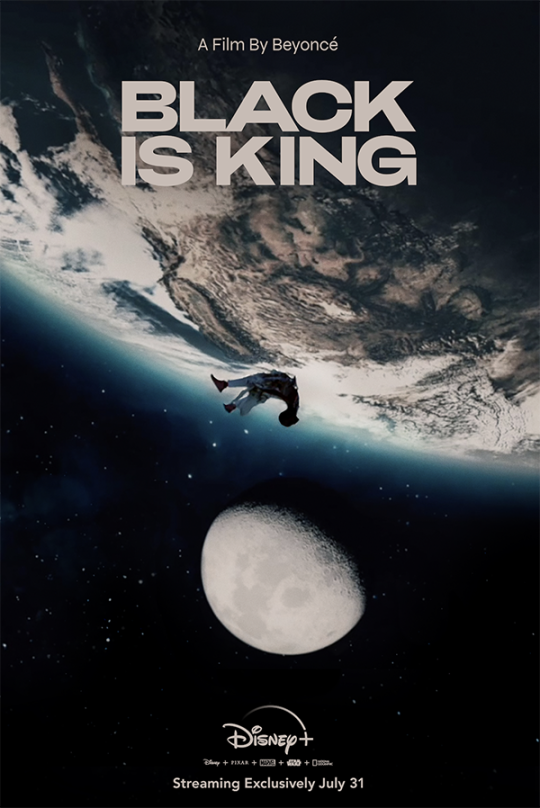
Beyonce’s latest visual album has its origins in her Lion King role, but the material transcends that misbegotten remake (despite the occasional out-of-place audio clips sprinkled throughout). The visuals here are stunning, from the costumes and makeup to the set design and choreography, all in celebration of Black excellence and beauty.
Emma. (available on HBO, VOD and Blu-ray)

One of the last films I saw in theatres this spring was the latest treatment of Jane Austen’s Emma from director Autumn de Wilde. Similar to Little Women last year, I had no prior experience with the source material, never having read the novel or seen any prior adaptations (outside of Clueless, if you count that), but I found it absolutely delightful. The cast is terrific, including Anya Taylor-Joy in a role completely different than her other big turn this year in The Queen’s Gambit, and the production design & direction are impeccably sumptuous, creating the type of escapism that came to mean all-the-more as the year wore on.
First Cow (available on Showtime, VOD and Blu-ray)

Kelly Reichardt’s latest film is a moving meditation on unexpected friendship, ideas of masculinity and economic inequality set against the backdrop of 1800s Oregon Country. Poetic but not ponderous, First Cow is one of the most humane and empathetic portraits of man and nature I experienced in 2020.
Hamilton (available on Disney+)

Already a big of Lin Manual-Miranda’s race-bent musical about founding father Alexander Hamilton, I was still awed by this document of the original Broadway production. Director Tommy Kail adeptly films his own stage direction while capturing intimate moments through closeups and vantages that are unavailable to the live audience. And while I personally may have preferred Lin to sing more than sob through some of his Act II songs, the whole cast is phenomenal, especially Leslie Odom Jr, Renée Elise Goldsberry and MVP Daveed Diggs whose energy and charisma are palpable in his dual role as Lafayette/Jefferson.
Just Mercy (available on HBO, VOD and Blu-ray)

Although technically a 2019 film, Just Mercy didn’t receive wide release until 2020 so I’m including it here. The adaptation of lawyer Bryan Stevenson’s memoir about his fight for death row inmates is a powerful story of the ongoing fight for justice and rarely falls into “based on a true story”/biopic clichés. Michael Jordan brings dignity and righteousness to the role of Stephenson and Jamie Foxx is excellent as the wrongfully incarcerated Walter McMillian.
Kajillionaire (available on VOD)

The story of an insular family of grifters, Kajillionaire explores what it’s like to exist in a bubble and reconcile that with a growing understanding of the wider world. Evan Rachel Wood engenders immense empathy with her portrayal of the family’s daughter who has been raised without any real physical affection or affirmation and Gina Rodriguez exudes light and charisma as a woman who comes into their orbit and changes everything.
Ma Rainey’s Black Bottom (available on Netflix)
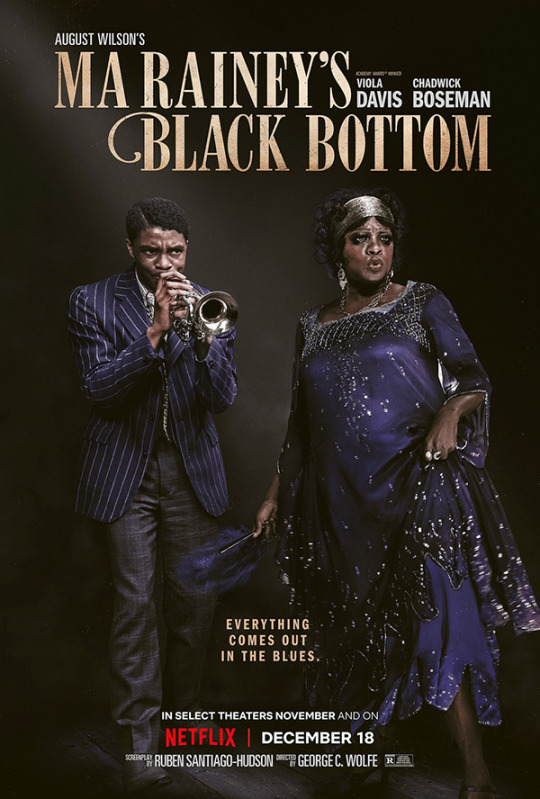
Adapted from August Wilson’s play of the same name, this film contains a powerhouse performance from Viola Davis as the titular blues singer but belongs to the magnetic Chadwick Boseman in his final role. As Levee, a brash young songwriter and musician, Boseman fully realizes a portrait of a talented and demeaned Black man in America, trapped by circumstance and his own feelings of helplessness. It’s beautiful and gut-wrenching to behold, and makes his passing all the more tragic as we can only imagine the great performances that we’ll never get to see.
Mank (available on Netflix)

Mank, a biopic about Golden Age Hollywood screenwriter Herman Mankiewicz, may be director David Fincher’s most conventional film yet, however that takes nothing away from the charm of its engaging storytelling and performances. As “Mank” works – or rather drunkenly procrastinates – on the screenplay for Citizen Kane, we get flashbacks of his relationships with William Randolph Hearst and Marion Davies, which will provide the basis for his script’s thinly veiled characters.
Small Axe (available on Amazon Prime)

A series of five separate films from director Steve McQueen, the Small Axe series is linked by its exploration of the West Indian community in London. Exploring topics including the justice system, educational disparity and the unifying & life-affirming power of music, these films are each powerful and moving on their own but add up to a rich and beautiful tapestry of the complexities of immigrant life.
Soul (available on Disney+)

Soul is in many ways a spiritual successor (pun intended) to Inside Out, my all-time favorite Pixar film, envisioning life after death (or is that life before life?) as a strange and delightfully stylized realm where new souls prepare to be born. The audience surrogate to this world is a frustrated jazz musician who finds himself incapacitated the day of his big break. The stunningly rendered film is another example of the studio – and co-director Pete Docter – at its heart-rending best with lovely observations about passion, mentorship and being present to life’s small pleasures.
The Vast of Night (available on Amazon Prime)

An indie sci-fi flick set in 1950s New Mexico from first-time director Andrew Patterson, The Vast of Night pays homage to the likes of The Twilight Zone better than the current reboot of that show does. This surprisingly compelling movie creates a tangible sense of time and place and utilizes innovative shots and blocking to deliver something unique and artful, while still delivering on its genre promises.
What the Constitution Means to Me (available on Amazon Prime)

The final live communal event I attended before everything locked down last spring was the touring production of this Heidi Schreck play, and boy, was it a moving way to say a temporary goodbye to live theatre (even if I didn’t quite know it at the time). Later in the year, Amazon gifted us with a record of Schreck’s Broadway run, which loses nothing of its impact or immediacy. Using her personal history of debate contests at American Legion Halls as an entry point, Schreck explores how the Constitution has been used (and not used) to impact the rights of women (and other marginalized groups) throughout America’s history. Brilliant, heart-breaking and inspiring art.
Wolfwalkers (available on AppleTV+)

The latest wonder from director Tomm Moore (The Secret of Kells, Song of the Sea) completes his trilogy of films inspired by Irish mythology. The topics this time are the Wolfwalkers, an Irish variation of the Werewolf legend, and the clash of urbanization with the natural world. Vividly rendered in gorgeous traditional animation, this is one of the most visually splendid things I saw all year.
Bonus! Honorable Mentions:
Eurovision Song Contest: The Story of Fire Saga (Netflix)
Feels Good Man (VOD)
Palm Springs (hulu)
Sound of Metal (Amazon Prime)
Tenet (VOD, Blu-ray)
0 notes
Text
Writing an immersive third person limited point of view.
What is third person? In third person pov the narrator refers to all character by third-person pronouns, such as he, she, or they. In contrast, first person pov uses the first person pronouns, I and me, for the narrator.
What is third person limited? Third person limited is the alternate to third person omniscient. In third person limited, you have one single pov character narrating the story at any given moment (though you can have as many of these limited pov characters as you want throughout the course of the story), whereas in third person omniscient, there is an omniscient (all knowing) narrator.
Why choose a limited third person pov?
- The reader forms a stronger, more personal connection to your pov character(s).
- You can easily build suspense because the reader never knows for certain what the non-pov characters are thinking, feeling, or planning.
- You can more easily write an unreliable narrator because your narrator tells things only as they see them, and not as they truly are.
At the end of the day, there is nothing you can’t do with limited if you’re creative and willing to think outside the box.
So you want to write a good limited third person pov then?
Keep in mind that most of these tips also translate to first person pov. In many ways, third person limited is very similar to first person, because you have a single narrator at any given time, and the reader is confined to that narrator’s interpretation of the world.
Here are some key things you need to remember while writing limited third person:
Fore note: I want to make clear that though I give a lot of extra explanatory information, this isn’t meant to be demeaning in any way, but rather to make sure that writers at all stages are aware of why certain phrases are used in third person limited. I hold very strongly to the opinion that any time writing advice is given, it should be clear why the person giving the advice believes it’s worth while, so that others can decide for themselves if it’s something they want to apply to their own writing.
The pov character can only sense the things their own senses can pick up, in exactly the way their senses interpret them.
Example:
Boots sounded behind him. [He heard the approaching person, but can’t yet see them because he’s not looking in the direction.] Anne appeared at his side. [She didn’t materialize there, but it’s implied that by ‘appearing’ she appeared in his specific line of vision]. The stench of blood and sweat coming off her made his knees weak. She must have just returned from the dungeons. [As the author, I would know that’s where she’s been, but our pov character can’t know this for certain unless he asks Anne. For now, he just has to guess.] Her brows knit together, and when she looked at him, anger flashed across her face. [Notice that he’s only inferring she’s angry by the signs he’s picking up. Either he knows her well enough to know what she looks like when she’s angry, or her anger is being displayed in a very typical human way.]
Note: You can (almost) always directly eliminate filter words like saw, watched, or heard. Some filter words like felt and smelled are harder to remove, but if you rewrite the sentence to get rid of them, it usually sounds nicer in the long run.
The pov character only knows the things they have experienced or been told already.
This includes obvious things, like the names of strangers. Some other examples of this are:
* The feelings of other characters (unless they’re clear shown through their actions, expressions, tone, etc. But even then, the character could just be a really good actor.)
* Whether or not another character is telling the truth (the pov character can guess they’re lying, but won’t know for certain).
* Information about the ongoings of the world beyond the things they’ve seen for themselves or learned from secondary sources.
The pov character only refers to themselves and others in a way which would make sense to them.
This is most relevant in a couple situations:
* The pov character doesn’t need to explain that they’re thinking, because the entire story is still essentially just an accumulation of their thoughts and perceptions. All first person thoughts should be italicized though.
* The pov character shouldn’t refer to themselves as any epithets unless it’s a unique situation where the character is debating the validity of their own identity. They should also not refer to their own appearance unless prompted.
* The pov character should only refer to others by the epithets they would normally use for that person, and should only note things about their appearance which make sense for them to note.
(It’s okay for that last guideline can be broken sometimes in order to help the reader. An easy way to avoid breaking is to find really noticeable things the pov character has a reason to describe. Did the pov character’s best friend put their red hair up in a new way? Does their scarf really match their blue eyes today? Does that coat look massive on their lanky body? Does their short height make them look like the perfect leaning post after a long day at work? If you start with something like this, you can easily work in more description afterward because the pov character is already focused on their friend’s looks.)
Example:
He shoved a hand through his hair, but the action only sullied his blonde locks further, rubbing the mud in between the strands. [He specifically thinks about his hair color because the mud is effecting it.] Gutter rat. Maybe he was meant only for the streets after all. [He indirectly uses an epithet for himself with the words ‘gutter rat’, but it’s been prompted by someone else shoving that part of identity in his face.]
He glared at the merchant as the man left. [He doesn’t know the merchant’s name, or maybe he does, but just doesn’t care, because he’s been mistreated by merchants who think he’s going to steal from them all his life, and has begun to label them all together in the same oppressive group.]
“Again?”
Swiveling around, he found Anne watching him from the side of the alley. [Anne is a low ranking soldier, but he only ever thinks of her as “Anne” because she’s his good friend, and not like most of the soldier’s he’s encountered.] Her dark hair had come loose from her bun, frizzing away from her face, and her button up shirt hung out on the sides, her overcoat missing entirely. [If this was Anne’s introduction, we now know that she has dark frizzy or perhaps curly hair, which she normally keeps in a bun, as well as a little about her uniform.]
She must have had a long day. [Notice that there’s no need to say “he thought” here. Also notice that since this isn’t specifically a first person thought, it doesn’t matter if it’s italicized. Italicizing it would draw more attention to it though, so if it’s something that will be a key point in the scene, italicizing might be better, whereas if it’s meant to be foreshadowing for the taxing undercover work Anne is doing for the rebellion, then it might be better not to draw attention to it.]
The words and phrases used to describe actions made by the pov character should take into consideration the way the pov character would interpret their own actions.
Examples:
“His eyes lifted to look at the stars” is always better written “He lifted his eyes to look at the stars” which is almost always better written “He looked at the stars” which is usually better written via some variation of “The stars shown down on him.” There are reasons why you might want to specify certain actions such as lifting eyes or looking at something, but it should not be used to show that the character is doing it, but rather to point out why the thing they’re doing this time (in this case, looking at the stars) is different from the other times that might have done so.
“He looked at the stars” might be useful if he’s literally stargazing in that scene. “He lifted his eyes to look at the stars” gives a feeling of helplessness by slowing down the sentence and forcing the reader to specifically imagine the pov character’s eyes rising, which works nicely if the pov character is scared and confused and he’s looking at the stars in the hopes that maybe he’ll find an answer written there.
Another thing to watch out for is including your pov character into a group’s action. If Anne and our pov character are running from the antagonist, it always should read some variant of “He ran beside her” and never “they ran.” (This is an exception to the similarities between third person limited and first person. In first person, you can say “we ran” without breaking the pov, but in third person “they ran” detached the reader from the pov character.) Find a better explanation here.
You can have any variation of different kinds of point of view throughout your story, but you must be clear to the reader which point of view you’re trying to use at any given time.
If you’re switching between different points of view within your story, the reader should know within the first paragraph after the break, or better yet the first sentence, which pov you’re using, and for first and limited povs, who the pov character is.
What does that mean for us? Try to avoid opening chapters like this:
Anne leaned against the balcony railing, the wind pulling at the stray stands of her hair. She tapped her nails against the wood in agitation, but the city folk traveling below seemed oblivious to her plight. Not a single one looked up.
He felt terrible for her. If only he could help in some way...
Here, we get a whole paragraph of Anne before the pov character is mentioned, a whole paragraph which could easily be from Anne’s perspective, or anyone else’s for that matter. (Note that the pov’s character’s name should be stated at the beginning of the chapter, instead of just their pronoun, but in our case, the pov character has no official name.)
All pov confusion can be easily been avoided by some minor rearrangement, like so:
He felt terrible for Anne.
She leaned against the balcony railing, the wind pulling at the stray stands of her hair. She tapped her nails against the wood in agitation, but the city folk traveling below seemed oblivious to her plight. Not a single one looked up.
Closing thoughts;
Keep in mind that these guidelines are a take on modern third person limited point of view, which is generally much more immerse and therefore stricter then the third person pov seen in most classics.
As always, “writing rules” are just guidelines and tools. As writers, we should always be open to breaking these guidelines if it fits with the story we want to be telling. The advice I give is what works for my own writing, and what seems to be the general audience’s consensus on what makes a limited third person pov more immersive, but is certainly not the only approach you can take.
More about breaking the rules here.
Ye ole copy-paste disclaimer to follow:
[This is my opinion. All opinions are subjective and were developed based on my own personal reading preferences and the reading preferences I see most commonly in my editors and beta readers. There are many aspects of this topic which I did not cover, and while I would be happy for you to add your own opinions to this post, please be respectful and understand that I did not exclude anything on purpose, in an attempt to mislead people, but rather to keep the post relatively short and tidy. In all matters of writing you should keep your own opinions and try many different styles and theories before settling on anything. As general rule of thumb, I believe that you should exclude nothing from your writing, but rather minimize the use of certain tools so that when you do use them, they have a bigger effect.]
#writing tips#writing help#writing advice#third person#point of view#writeblr#amwriting#immersive storytelling#writing tag: other#other tag: pov
2K notes
·
View notes
Text
Doctor Who Series 12 Review Part 5/10: Fugitive of the Judoon

Air date: 26 January 2020
The Doctor Who fandom is in further meltdown this week as we deal with further bombshells on top of all the bombshells from the series up to this point.
My spoiler-free thought for this episode: “We’re gonna need David Tennant back at this point to explain what is going on.”
At this point, I have caught up with the last three episodes. Weekly posting of reviews will continue from next week. Spoilers continue after the break. Make sure you’ve watched the entire series up to the end of this episode before you continue on.
That big bombshell
Before the series started, we did get confirmation that the Judoon would be returning. That was a pretty good cover for this episode.
This week, we saw the debut of a new Doctor played by Jo Martin. Talk about representation, amirite? Look, in all honesty, I’m not too worried about this being an SJW red flag over this being something that could potentially rattle the status quo of Doctor Who. John Hurt as the War Doctor did do that, but eventually, we came to understand that it was because of three reasons - there was a discrepancy between the Eighth and Ninth Doctors in that there was no regeneration, Christopher Eccleston was unable to return for the 50th Anniversary and Steven Moffat wanted to explore what would happen if the Doctor used up all twelve regenerations.
On a side note, Jo Martin is pretty good as the Doctor. It should also be noted that she is the first black Doctor in the series (maybe not actually the Doctor depending on how this series turns out). What are the chances that this was done for fanservice because people were expecting a more radical choice for the Thirteenth Doctor (as if Jodie Whittaker being female and a feminist wasn’t radical enough)?
Personally, I’ve never been a fan of Chameleon Arch stories. I think that if you (forcibly) conceal yourself as a lesser species despite having superior powers, abilities and knowledge, then it demeans who you really are and makes you look like a bit of a coward. John Smith put it best in The Family of Blood when he was struggling over whether to open the fob watch and become the Doctor again as it meant that this John Smith wouldn’t exist anymore. In the end, he didn’t stand up and insist on staying John Smith, thus making him a coward either way.
So, upon becoming the Doctor again and learning that 13 is also the Doctor, Ruth (we’ll call her this from now on) surmises that the Doctor is from her future, yet the Doctor doesn’t remember being Ruth. Given the design of her TARDIS and her not recognising the sonic screwdriver, I’m surmising that Ruth is based on the classic series Doctors. Let’s take a look at three possible theories I’ve come up with.
Theory 1: Parallel universe/Alternate timeline
This seems to be the most popular and easy-to-explain theory among fans. It would certainly explain the Master’s reappearance and it doesn’t change the status quo too much. However, Chris Chibnall said that Ruth is “definitively the Doctor” (how that sentence even makes sense I don’t know) and that there is no parallel universe involved, which could potentially jeopardise everything.
The Doctor Who Wiki documents many incarnations and alternate versions (including non-canonical versions) of the Doctor other than those we have seen onscreen. However, the fact that Ruth might come from a parallel universe would be too simple unless it’s part of a bigger thing in the story arc. I’m foreseeing a Dimensional Merge thing going on.
(If Peter Cushing actually ends up being acknowledged as canon or an incarnation of the Doctor onscreen, then I’m going to be pissed)
Theory 2: The Valeyard
The Valeyard, a villain from the Sixth Doctor’s Trial of a Time Lord series, was seemingly forgotten until it was mentioned twice in the Moffat era, during The Name of the Doctor and Twice Upon a Time. The Valeyard is apparently an amalgamation of the Doctor’s darker sides from between his twelfth and final incarnations - in terms of the Doctor’s first set of regenerations, it would technically be between the Tenth (post-Journey’s End) and Eleventh Doctors. However, now with the Doctor’s new regeneration cycle, people seemingly like to stretch it out to after the Twelfth Doctor’s era, so anything goes at this point. It would explain Ruth’s darker side during the confrontations with the Judoon and her willingness to bear arms when the Doctor opposed it.
Theory 3: Pre-Hartnell Doctor
This would be the most dangerous theory because it would drastically change the status quo of Doctor Who. During the Moffat era, the show seemed to reinforce the fact that all and only all of the Doctor’s incarnations up to that point were the Doctor. The child we saw in Listen was basically the First Doctor.
The details of the Doctor’s birth and upbringing are very conflicting because different Doctor Who-related media seems to have their own interpretation of it. The 1997 Virgin New Adventures book Lungbarrow details how The Other, one of the original founders of Time Lord society alongside Rassilon and Omega, would reincarnate himself into the loomed Doctor. I don’t like the idea of the Looms, though, so things might be questionable for me if they are canonised. Chris Chibnall has said in an interview around the start of Series 11 that he had not been able to find a copy of Lungbarrow, but chances are that whatever happens will be even more complicated than whatever I’ve theorised.
The return of Captain Jack Harkness
This was another surprise in this episode. As such, this makes Jack the first companion from the revived era, or more specifically, the RTD era, to reappear in the series. Sadly, the return of Jack Harkness may have been fanservice as well as Chibnall also said that he won’t be appearing again in Series 12. If you’re going to have fanservice in order to advance the story, then the fanservice should be more involved in it, like Rose Tyler in Series 4. With the announcement that the Cybermen would return in the Series 12 finale, I would have expected Jack to return then.
So what did Jack warn Graham, Ryan and Yaz about? He had them tell the Doctor to “beware the Lone Cyberman” and not to give it what it wants. He also mentions that an “alliance” sent something back through time and that somehow because of it, the Cyberman empire is in ruins. What this and/or Ruth have to do with the Timeless Child we have no idea yet, but I’ll be sure to keep watching.
Other general thoughts
Since the term was coined in the 2017 Free Comic Book Day comic The Promise, the fob watch portion of the Chameleon Arch has been known as the biodata module. The fire alarm in the lighthouse acted as Ruth’s biodata module; having it in a stationary location does make it harder for it to be noticed, particularly if perception filters are involved.
In the next time trailer for this episode, I thought that Ruth was Grace. And people say all Asians look the same.
Why didn’t the Doctor ask more questions to Ruth if she was confused at whether she was her or not?
Ruth gives the Doctor five points for guessing how she disguised herself on Earth. We haven’t seen the points system for a while now. For those of you keeping track at home, Yaz is on 10 points (S11E5), Ryan has a gold star, which I presume to be 10 points (S11E6) and the Doctor is on 5 points. Way to underestimate.
Following this episode, the next two episodes are also co-written by Chris Chibnall. Whether they will have more details to build onto the story arc is unknown yet.
Summary and verdict
No tokusatsu references in this episode. There was a big SJW red flag, but that was overshadowed by the story arc. Regardless, Ruth and Jack served as mere fanservice to advance the story and I expect to see them again soon.
Once again, I’ve finally caught up on the episodes now, so we will be returning to the normal posting schedule next week. I didn’t complete all the reviews for the last three episodes all in a day - my mind gets tired whenever I’ve done something big.
Rating: 8/10
Mid-series review
Compared to the same period in Series 11, the first half of Series 12 was definitely more dramatic than Series 11. We had a two-parter reintroducing the Master, a story about climate change and an Edison vs. Tesla episode. I thought there weren’t going to be a lot of SJW red flags, but Episode 3 alone proved me wrong. Still, the SJW agenda is less of a problem for me this year than it was last year (though I’m still going to be cautious).
Here are my ratings for the series so far:
Episode 1: 8/10
Episode 2: 8/10
Episode 3: 5/10
Episode 4: 9/10
Episode 5: 8/10
Mid-series total: 38/50 (76%)
Compared to the mid-Series 11 total of 70%, this is probably the better series for me so far. I think the returning characters and story arc really helped.
Stay tuned next week as I review the sixth episode, Praxeus.
#doctor who#doctor who series 12#thirteenth doctor#doctor who series 12 review#thirteenth doctor review
0 notes
Text
About Art, Asks & Roleplay
Welcome to my Monster Hunter themed art, roleplay and ask blog.
About Art:
I draw all the art posted on this blog, unless otherwise stated.
My current art software is Procreate app on iPad pro, that I use with an Apple Pencil (I’m not a particular Apple supporter but I am way too much in love with Procreate which is sadly exclusive to iPad).
I do not take requests, and receiving an ask from your character doesn’t mean I will draw them (except for feral Monsters from MH).
I occasionally take commissions, though I can be pretty slow at getting them done. Click here for the last updated commission price chart. Contact me by private messaging or email ([email protected]) for more information.
About Roleplay:
Aside from non-canon RPs in Alternate Universes (AUs), my characters remain in the world of Monster Hunter. I have close to no restrictions on playing with MH-themed characters. Other OCs are fine as well, if they have a reason to find themselves in this world. I might be picky about other fandoms’ characters.
I currently have little time to roleplay because of my studies, so I’m following a ‘few RPs, high quality’ logic. Unable to roleplay with everyone, I may be selective about my RP partners.
No explicit NSFW content is tolerated on this blog (not to mention Tumblr’s rules).
Little time to RP also means I may not reply very fast! I can take up to one or two weeks. After that time without news from me, you may send me a polite reminder.
I often put a lot of effort in each of my replies, so I’ll appreciate that you do the same. I usually try to adapt my replies to the lengths of my RP partner’s replies. However, especially on plotted/planned RPs (that didn’t start from a compulsive ask for instance) I prefer working with reasonably long replies, with at least two or three paragraphs. Correct grammar is required (please proofread your own reply before posting it!)
I like adding illustrations to my RP replies to make them more thrilling to read. Each illustration is drawn by the mun myself, and used only once, for one RP post. That can delay my pace of replies as well. If you think the pictures are too big (compared with usual icons) you may tell me and I will make them smaller.
I tolerate reblogs of my RP posts by readers who don’t take part in these RPs, especially with a small personal comment about the thread. But you may have to ask the other player as they don’t necessarily appreciate it. Either way, feel free to tag me in your own text post about the thread if you like!
Especially in fighting RPs, be fair-play ! If you do powerplaying (your characters are too powerful / too omniscient), or godmodding (controlling my characters’ actions in my place without my permission), I might or not start doing the same; but either way I’ll be annoyed which tends to strongly reduce the lifespan of a thread. To avoid that, read your post again and try to put yourself in the other player’s shoes to imagine their reactions. I am open for pre-plotting if you like!
About Asks:
Diversity and inventiveness are encouraged regarding asks. They also may be related to current RP threads.
OOC asks are welcome as well!
I can be picky about the asks I reply to, depending on how much they inspire me at the moment, and the available time I have. I also usually try to keep the flow of asks organized and only answer when they are related to the current story.
Sometimes I can answer asks in a weird order, digging up old unanswered asks if they fit some current events or if they were too much off-topic at the moment they were sent.
Like RPs, no NSFW on this blog (suggestiveness can be fun sometimes, but the replies will stay safe).
No demeaning godmodding, don’t make my characters do things or be subjected to degrading treatments (especially those meant to leave a mark, such as storming in and cutting Teo’s mane), except within the scope of self-mockery situations or some kinds of ask-memes. This blog’s got proud muses and is run by a proud Mod, I can get quickly annoyed if my characters are humiliated against my will! (this is very selfish I know)
About Characters:
Aside from AUs, my Monster characters can’t switch between forms. In my canon story, there are two parallel universes, one with Feral Monsters and one with Gijinkas (humanoid). The main events take place in both universes.
Teo’s character sheet is available.
You are more than welcome to draw my characters if you wish so! Make sure to show me the result!
14 notes
·
View notes
Text
Review: Hidden Figures
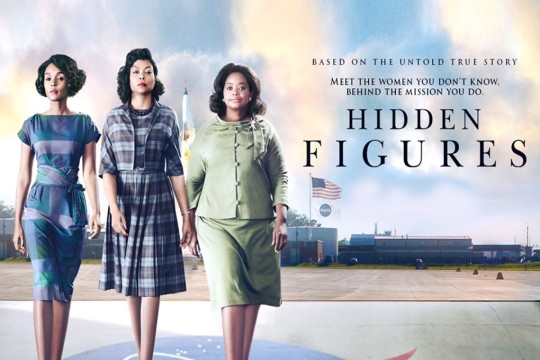
The women in Hidden Figures are presented as under-respected harbingers of an era that dissolves borders, in no small part thanks to their own convictions that such dreams can become reality.
X-Posted at Forbes & Fifth
Based on the eponymous non-fiction book by Margot Lee Shetterly, Hidden Figures is a semi-biographical drama film that boasts Theodore Melfi (of "St. Vincent" fame) at its helm. A modest one-hundred-and-twenty-seven minutes in length, the film functions in equal parts as a chroniclization and a social commentary of the struggles endured by female mathematicians at NASA during the 1960s, when both the Civil Rights movement and the Space Race were at their zenith.
At its most basic, Hidden Figures is a counter-narrative that offers illuminating insights into the lives of these pivotal African-American women, whose efforts undergirded one of America's crowning achievements – but who were swept into obscurity by the tide of mainstream history, the flow of which is arguably dictated by white androcentrism. At the same time, the film masterfully interweaves the parallel trajectories of the aerospace industry and the Civil Rights era in such a way that they complement, rather than negate, one another in order to catalyze some of the most conspicuous manifestations of globalization. Their scope includes the launching of satellites for both global surveillance and rapid channels of communication, to the birth of information technologies that sparked trends in global networking and organizations built on international cooperation, to new platforms for social movements championing equality, which re-scaled the contentions around racial justice to worldwide dimensions.
These advancements are significant not only for their historical clout, but because the undercurrents continue to carry through in social dynamics and technological achievements today, offering potent clues about human societies and their continued survival. Indeed, Hidden Figures, at its crux, is about survival – whether through individual ingenuity in the face of blatant prejudice and subtle microaggressions, or through the slow but deliberate erosion of hierarchical structures entrenched in racism, sexism, and tribalism.
Tackling any one of these issues on its own would prove an enormously tall order. Exploring all of them, concurrently, runs every risk of dissolving the plot into a chaotic tangle of hopelessly overambitious themes and saccharine, oversimplified messages à la Hollywood. Yet, for the most part, the film avoids them with both cleverness and panache – largely by never losing sight of its premise as both a foundation and a fulcrum.
More than an amusing pun on the infallible logic of numbers when used and applied correctly, or the deliberate erasure of those who made those same complicated calculations possible, Hidden Figures explicates, via its three main characters, the nuances of power, tension and belonging in segregation-era America, while each woman moves through varying social structures. They are hidden figures not merely in the context of their underappreciated work, but because they are invisible yet immensely influential widgets cultivating broader social change – even if said change may not be fully visible until years or even decades afterward. We meet Taraji P. Henson's indomitable Katherine Goble, who first steps with trepidation into the cluttered, all-white, nearly all-male whirl of the Space Task Group Office, and is alternately ignored or demeaned by her colleagues, yet ends the film in the tracking control-room, shoulder-to-shoulder with the rest of NASA's most brilliant minds as John Glenn is launched into space. Moving forward, we are introduced to Janelle Monáe's zesty and plainspoken Mary Jackson, who successfully petitions the Hampton County Courthouse to attend an all-white school despite her husband's well-meaning skepticism, then goes on to become NASA's first black female engineer. Finally, we get to know Octavia Spencer's salt-of-the-earth Dorothy Vaughan, who gathers the mettle to demand a promotion after being perpetually taken for granted, and ultimately triumphs as the first black woman to supervise a staff at NASA's center. The film makes it clear that these women are pioneers not simply owing to their individual merits, but because they represent the larger group of black female mathematicians who toiled tirelessly in their offices, unrecognized yet integral to winning the Space Race.
Detailing the struggles each woman endures is daunting enough, yet there are far more subjects successfully interwoven through the fabric of the film. There is U.S history, global politics, social disorder, gender dynamics, professional uncertainties and mutually-encouraging friendships in a kaleidoscopic mélange. These are tackled through the film’s exploration of the awkward position Katherine occupies as the only African-American woman in her workplace, and simultaneously as a single mother of three daughters at home. They are further highlighted in the myriad obstacles women of color, and in this particular context, African-American women, had and continue to struggle against owing to both gender-and-racial-biases. Finally, they are present in the film’s palpably tense portrayal of life in Cold War America, and in the violent social disruptions that characterized an era of rising Pan-Africanism, giving voice to bitter complexities of black social and political identity, but also to the technological leaps that were seminal to the globalization process.
Many might argue that Melfi has bitten off more than he can chew. The film is brimming with clips and offhand references to historical events – from Russia's successful launch of Sputnik, to snippets from Kennedy's iconic speech, ("We choose to go to the moon in this decade and do the other things, not because they are easy, but because they are hard,") to references to the landmark case of Brown v. Board of Education in the context of Virginia's dogged adherence to segregation, to footage of the KKK firebombing of the Freedom Riders' bus in '61 – yet the outcome is atmospheric rather than forced. The characters portrayed by Henson, Spencer and Monáe are not bland placeholders within a didactic history lesson, but dynamic players in a social drama that they also have the power to shape. Their victory is not exclusively in the swiftness of the short-term outcome, but in the new avenues it forges, allowing these women, and others like them, to march forward and push for greater change in the future. In his work, Freedom Dreams: The Black Radical Imagination, Robin D. G. Kelley remarks that when examining groups that advocate for social progress, there is a tendency to view them through the lens of whether or not they "succeeded in realizing their visions rather than on the merits or power of the visions themselves (9)." Not only does this encourage audiences not to succumb to the 'horse-race' fallacy of prior historians, but also to remember that change is not always apparent and instantaneous.
With that in mind, another commendable aspect of the film, despite its inherently busy narrative, is that the individual and social changes rarely feel forced and come across natural to real life. For instance, Katherine does not receive respect and recognition for her efforts overnight (indeed, the fact that the original Katherine Goble did not receive an Astronomical Society Walker II Award until 2016, is meta-level irony at its finest – or cruelest). Instead, the film makes it clear that it is the pivotal launch of Sputnik, and America's frantic efforts to play catch-up, that lead to the Space Task Group, under pressure from the top, to recruit an Analytic Geometry specialist: "You know what's dangerous? Inaction. Inaction and indecision. The Russians have a spy satellite lapping the planet… No more delays… just get us up there"(00:09:16).
In his work, The Unraveling of America: A History of Liberalism in the 1960s, historian Allen Matusow remarks that Sputnik "...struck a devastating blow at America's self-regard and sense of security. If the Russians had Sputnik, a host of commentators concluded, they probably had intercontinental ballistic missiles. If they beat us into space they must be forging ahead in science, technology, education." In the wake of this unsettling new reality, Americans were forced to confront real or perceived failings in their systems. Social criticism "… became fashionable again (9)." Small wonder, then, that there was a dramatic shift in the nation's educational policies, and that African-American groups were vociferous in their demand that black students receive both academic resources and recognition, as ignoring such an "untapped resource of intellectual and scientific brainpower would be a foreign policy disaster for the U.S during the Cold War (Thompson 20)."
Within this volatile social climate, the demand for math wizards like Katherine arises out of brute expedience rather than genuine meritocracy – a fact that is further testified by the prejudicial and obstructionist treatment she receives from her colleagues. NASA's milieu of cutting-edge technology, blackboards covered in complicated equations, suited men in sleek office spaces and gravely-dignified meetings filled with an implicit drive to achieve the unachievable, juxtaposed with the disrespect Katherine is subject to, all highlight the gulf that exists between America's technological advancements and its social equalities. More to the point, they are reminders that NASA cannot justifiably break barriers in space without addressing the insidious but no less damaging ones that exist within and among its own people. In his book Apollo in the Age of Aquarius, Neil Maher discusses the tendentious relationship between the Civil Rights movement and the Space Race during the 1960s, intimating that the failings of one could not be corrected without addressing the needs of the other:
In an attempt to appease criticism … NASA engineers and scientists reoriented some of their space technology toward more pressing urban problems, especially those affecting African-Americans, including air and water pollution for sewage and garbage disposal and unhealthy living conditions. The civil rights movement in other words was bringing the Space Race back down to earth. ... [Ultimately, NASA] transformed civil rights by shining an extremely bright public relations spotlight on the movement. In the Kennedy Space Center VIP viewing area, as they waited for hours for the Apollo 11 countdown, [Ralph] Abernathy and the families joining him consciously worked the captive audience. 'This is really Holy Ground,' he stated during an impromptu address to the politicians, foreign dignitaries, movie stars, and, most important, the dozens of reporters who were all waiting for the rocket to roar into the air. 'But it will be even more holy once we feed the hungry and care for the sick and provide for those who do not have homes' (50-51).
Yet, for these bleak and lopsided social dynamics, the film's message is tinged with hope. Time and time again, the protagonists are told, "That's just the way it is," yet they respond not with passive resignation but a quiet resolution to take matters into their own hands. At each turn, Melfi reminds audiences that ironclad conceptions of reality within specific societies, and their surrounding notions of naturalness, are in fact arbitrary constructs that can be shaped and re-shaped according to human efforts. At the outset of the film, Katherine's boss, frustrated and stymied by their team's repeated failures to launch ships into orbit, questions whether it is even possible to make his dreams of reaching the moon a reality. By the climax of the film, although NASA has not achieved the desired moon-landing, they have nonetheless launched John Glenn into space – a series of ascending leaps that can only guarantee they will soar higher. In the process, the organization has also made small but hugely significant steps towards an environment of greater equality and acceptance, from desegregating the bathrooms, to hiring Mary as their first black engineer, to allowing Katherine, as the first ever woman, to attend the highly-classified NASA briefing. Each time, the achievements are quiet, understated, yet carry potent resonance: a reminder that human beings have the capacity to shape the space around them, on both an individual, national and ultimately global scale. The film's ultimate scene -- where Katherine sits in the near-empty Space Task Group Office, typing up a report bearing both hers and her initially-hostile colleague Paul Stafford's names in tandem, while Paul himself, in a gesture of matter-of-fact camaraderie, brings her a cup of coffee – is touching not only for its redemptive warmth, but for the lack of fanfare that characterizes it (01:58:14-01:58:20).
Similarly, the film does not aggrandize NASA's technological breakthroughs, but calls the audience's attention to the innovators who not only made such achievements possible, but who are the literal and metaphoric 'hearts' that keeps them alive. In an earlier scene, Katherine, Mary and Dorothy nervously discuss the eventual operation of the IBM – the first transistor-based computers, meant for the scientific computing that was previously done by their department. They are prepared to accept the machine's superiority to them in terms of efficiency and speed, but are nonetheless determined to understand and master its intricacies: "It'll run eventually. We have to know how to program it once it does. Unless you'd rather be out of a job?" (00.59:22). The IBM computer, and to an even greater extent, the satellite, are both NASA-spawned innovations that were perfected during the Cold War, yet instrumental in ending it as they ushered in what sociologist Robert Roland defines as the "fifth phase" of globalization, within which the world came to be defined not "in itself" but "for itself," with all the uncertainties and possibilities that go hand-in-hand within a transnational realm of shrinking boundaries.
Yet, as the women in the film remind us, the march of globalization does not necessarily trod humanity underfoot, but can be mastered as another extension of our dreams, whether individual or collective. Similarly, societal haves and have-nots do not exist as a disembodied vacuum, but as an expression of symbolic, political and economic disparities, allowed unchecked reign. The women in Hidden Figures are presented as under-respected harbingers of an era that dissolves these borders, in no small part thanks to their own convictions that such dreams can become reality. Yet Melfi's message is neither cloying nor moralistic; the film is a critical reminder that the struggle towards equality and unity is far from over. At the same time, there is an implicit exhortation to never stop fighting for that change. Within an increasingly globalized sphere, birthed by the innovations – technological, social – of NASA, change is the only constant, and the transformations sparked by globalization are not simply part of the world, but, conceptually, an ever-breathing, ever-expanding imprint of it. It is an imprint that we ourselves can shape, through both the existing wisdom of those who fought before us, and also through the clarity and knowledge that any phenomenon that fails to bring true equilibrium, inward and outward, will ultimately collapse beneath its own weight.
For Hidden Figures, it is not enough to interweave the parallel trajectories of the aerospace industry and the civil rights era to highlight globalization in its most pivotal manifestations. Rather, it is to ensure that we, as the audience, understand that those manifestations are thanks to individuals too-easily forgotten within a fast-paced and self-serving world – but who must be remembered, lest we forget the very lessons our future is built upon, and our capacity to see the world as one.
Works Cited
Kelley, Robin D. G. Freedom dreams: the Black radical imagination. Boston, Beacon, 2002.
Maher, Neil M. Apollo in the Age of Aquarius. Cambridge, MA, Harvard University Press, 2017.
Matusow, Allen J. The unraveling of America: a history of liberalism in the 1960s. Athens, Ga, University of Georgia Press, 2009.
Melfi, Theodore. Hidden Figures. 20th Century Fox, 2016.
Robertson, Roland. Globalization: social theory and global culture. London, Sage, 2000.
Thompson, Mark A. Space Race: African American Newspapers Respond to Sputnik and Apollo 11. Dissertation, University of North Texas, 2007, UMI: 1452031
0 notes
Text
Oedipus and Otherkin: A Deleuzean Analysis of Kinning
When discussing identities that do not directly reference, or only passingly reference, a Western structure of binary division, frequently there is a reactionary turn toward a sort of phantasmic notion of “otherkin” as a hegemonic group, one blamed for the slow progress of trans rights or critique of gender, as a symptom of postmodern affinities and structures of identity rather than merely elucidated through this vocabulary, as a product of a pathological schizophrenia rather than a means of describing a certain, growing experience of the schizophrenic character of late capitalism. While not creating a new ontology of otherkin, I wish to explore the conceptual framework provided by such designations as part of talking about the means by which they express other, hierarchical structures as part of a larger arboreality of experience toward the body and how the knots of rhizomality within this arborescence are important to consider in themselves. In order to critique the means by which “otherkin” as an identity is often reckoned, one must note a great deal of disparity between the socially acceptable subject and the one upon which the imagery of “otherkin” is often projected, additionally understanding that this disparity is not a structure of stability, that in fact in great part it relies upon destabilization and deterritorialization as a process in order to become-realized.
First, that such a great deal of criticism of jokes or critique around concepts of “otherkin” identity lies in discussions of ableism (itself a concept which incorporates both a realization of disparity, and disparate means of reckoning the self) along with age as a demarcation often realized through violence as well as neurotypicality as a violent structure, must be countered with the acknowledgement that there is frequently an errant character to this process of accusation, that there is not a structural violence against otherkin and merely the realization of other structural violences through a process of signifying these structures through the use of a notion of otherkin and the further development of a semiotic system around the label as such. It is a rabattement, a redoubling, and rightfully noting this is not in contradiction with any critique (including positive critique) of otherkin identity, nor should it be taken as a defense of the means in which these accusations are often used in order to delegitimize and decenter a meaningful accusation. This is of little practical difference from other attempts at negation or obfuscation of criticism, of meaningful critique, and to claim that it is unique to otherkin as a group is to effectively assume that all reactionary critique can be limited to a rather small online community when reactionary critique is a vital part of liberalism, has effectively become the ideological standpoint of the Democratic Party, anticipated by earlier structures such as Blairite Labour and the further realization of supposed “centrist” parties in global politics. Otherkin can act in reactionary fashions, can pass along structural violence, can themselves enact it. They can be abusers, rapists, racists, can commit violence of any sort, but to specifically imply that any status as “otherkin” creates a special relationship with these violences rather than being a site of them, in positive or negative description, is to effectively assume that a singular structure can explain all violences, a notion that is indefensible.
Conversely, what must be acknowledged is that many otherkin are otherwise vulnerable based upon structural demarcations of identity: they are often trans, young, have a pathologized neurotype and thus assumed to be only secondarily aware of their own phenomenological experience. The means by which otherkin are often reckoned is in no small part due to the means by which, as part of an assemblage of identity, it can provide a great deal of coherence between the process of producing-consumption, through the media that they feel most immediately drawn to or the knowledges that most interest them, and a direct identification between that and other structures of the “self” as marked within the creation of the subject. That otherkin often use “neopronouns” marking their identity and describe their gender with the use of a highly atypical, poetic vocabulary is a specific means of deferring the judgment usually exerted through the collapsing act of “reading” young trans bodies: they know that their identities will not be respected, they know that they will be faced with criticism regardless of their gender identity, and thus an ostentatious process of playing with the label of gender ensues. This is not to be taken as a means of justifying the structural violence of gender, nor to justify a turn towards sex essentialism or even a pathologization of the structure of transness that concentrates upon dysphoria. The notion of dysphoria itself, as well as its supposed reversal in “gender euphoria”, relies upon a standard of encountering and collapsing bodies that lies in specific Oedipal structures of colonial ontology of the body.
The description of “gender euphoria” as a sort of reversal of the predominating discourses around dysphoric experience can be occasionally useful but it requires such a great deal of exegesis in order to be meaningfully applied that seeing it as much other than a mildly amusing turn of phrase can be problematic when discussing the structure of transness and the way in which it is arbitrated through larger performative markings of gender. Recognition of an apparent “success” in expressing a certain gender is not to be understood as for-oneself, as the notion of gender at all being possible for-oneself requires a commitment to gender as a priori meaningful rather than part of a complicated assemblage of relations that holds no singular origin. Largely, ascribing these processes of identification to the label itself, rather than the relief that can be implied by finding a means of presenting which will cause fewer moments of dysphoric triggering, will be less dangerous, will make less clear one’s relationship to transness, is part of understanding identification through the label as a sort of Oedipal act of naming rather than understanding the semiotic turn of the label.
That being kin, that identifying as kin with a concept or character involves this process, involves merely naming a specific assemblage of series of identifying qualities as part of developing alternative structures of identity and selfhood that rely upon a sort of deconstructive approach to a text as an assemblage of characters. That these forms of identification develop to historical figures is hardly surprising, given the means by which fiction is so often the means of communicating a historic tendency, in addition to the fictive nature of history as a process. That Hamilton has given rise to a number of kintypes of “Founding Fathers” is somewhat disheartening but hardly surprising, and that those involved occasionally offer a more meaningfully critical ideation of the settler-colonial history of the United States than those of similar age who claim to merely admire the same figures is tied to the general vulnerability of many drawn to otherkin circles. Identifying with space, with the sea, with cats or dogs or robots, specifically calls into question the process of becoming-animal and becoming-imperceptible that is laid out by Deleuze and Guattari, in that these becomings are in part realized within and moreover through the bodies of otherkin, as part of developing an otherkin experience. This is not to say that the only means of moving forward in these directions is to “become-otherkin” but rather that affinity which radically acts to recast the body, to shrug off the limitations of the body not just through an alteration of the physical, but a violently deterritorializing abandonment of the current conceptual body.
Again, after spending so much time discussing kinning as a potentially positive experience, attention must be paid to the failures or at least problems such identities may present in critique. Being “kin” as a means of excusing violent behavior is, again, not uniquely separated from other justifying behaviors connected to these structures. Rather, its uniqueness must be tempered by a willingness to criticize the way in which a process of assumed-offense, of taking offense not at violence, but rather at a perceived similarity to a structure of violence that specifically refuses to analyze such violence, that instead demeans and negates it, is part of what allows such violence to continue. That identity is leveraged as part of defending oneself is in no way unique here, but that must not be allowed to obfuscate that it indeed presents itself recognizably within processes of ordaining oneself as “otherkin” in regards to other identities. The destabilization through which identity thus becomes coherent must be understood within a greater context of identification and Oedipal traumatization of the body as a whole.
18 notes
·
View notes
Text
Alternis Task 2 | Sirius Black
1. What is your character’s zodiac?
SCORPIO
(October 23 - November 21) The Scorpion. Fixed, water, yin. Planetary rulers: Mars and Pluto. Keywords: "I DESIRE"
Scorpio is the eighth house of the Zodiac and governs the genitalia. Positive traits include magnetic charisma, ambition, drive, a penetrating mind, curiosity, intensity of focus, emotional depth, consistency, persistence, willpower, and the potential for inner transformation and regeneration; negative traits include selfishness, obsessiveness, vindictiveness, hypersensitivity, ruthlessness, cynicism, an inability to understand the word "moderation," and jealousy. It is said that Scorpios embody both the best and the worst of all that are born under the stars, and that there are three kinds of Scorpios: wicked scorpions, cunning serpents, and saintly eagles. What each Scorpio becomes is entirely up to that Scorpio.
~
Expect stamina, incredible courage, intense and stormy emotions, burning idealism, and indomitable will. Gryffindor Scorpios are never drawn in shades of pastel; they are always blood red and mesmerizing gold. There are few followers born under these aspects; Scorpios born into this house tend to be either leaders or loners. They are well placed on the Quidditch field, where their natural competitive streak and their great store of personal energy make them natural Beaters (or, really, naturals at any position on the field). Expect them to get into frequent duels, and expect them to gravitate naturally to DADA, for all Scorpios are fascinated by anything dark and forbidden, and Gryffindor Scorpios will want to take their place as defenders as early in their careers as possible. Expect passion. Expect wisdom. But don't expect a lot of time to take a breather. Many people born under this aspect also end up as Aurors; they're the perfect "bad cops" to the "good cop" Libra wizards.
2. What is your character’s moral alignment?
CHAOTIC GOOD.
A chaotic good character acts as his conscience directs him with little regard for what others expect of him. He makes his own way, but he's kind and benevolent. He believes in goodness and right but has little use for laws and regulations. He hates it when people try to intimidate others and tell them what to do. He follows his own moral compass, which, although good, may not agree with that of society.
Chaotic good is the best alignment you can be because it combines a good heart with a free spirit. Chaotic good can be a dangerous alignment when it disrupts the order of society and punishes those who do well for themselves.While creatures of this alignment view freedom and the randomness of actions as ultimate truths, they likewise place value on life and the welfare of each individual. Respect for individualism is also great. By promoting the philosophy of chaotic good, characters of this alignments seek to spread their values throughout the world. To the chaotic good individual, freedom and independence are as important to life and happiness. The ethos views this freedom as the only means by which each creature can achieve true satisfaction and happiness. Law, order, social forms, and anything else which tends to restrict or abridge individual freedom is wrong, and each individual is capable of achieving self-realization and prosperity through himself, herself, or itself.
Chaotic good characters are strong individualists marked by a streak of kindness and benevolence. They believe in all the virtues of goodness and right, but they have little use for laws and regulations. They have no use for people who "try to push folk around and tell them what to do." Their actions are guided by their own moral compass which, although good, may not always be in perfect agreement with the rest of society.
These characters are basically good, but tend to be selfish and maybe a bit greedy. They tend to hold personal freedom and welfare above anything else. The chaotic good dislikes confining laws, self-discipline, and they distrust authority.
Chaotic goods believe that freedom is the only means by which each creature can achieve true satisfaction and happiness. Law, order, social forms, and anything else which tends to restrict individual freedom is wrong, and each individual is capable of achieving self-realization and prosperity through himself. These characters believe that life has no grand plan, but each creature's spirit is essentially noble and good. Each being must follow his own conscience. By performing good acts the individual can hope to alleviate the suffering and anguish of others, whether caused by random or structured acts.
The chaotic good character has a "beatific" attitude toward existence. In this character's opinion, any laws, social structures, or other such hierarchies that restrict his freedom are abhorrent and to be done away with. The inviolable right of the individual to seek his own pleasures is one of the cornerstones of society; but, being good, the chaotic good being will not tread on others to get his own way, for he feels that every other creature has the right to the pursuit of pleasure as well. Friends of a chaotic good character will find him unreliable in the clutch only if he puts his own well-being ahead of that of his companions. Obviously, almost everyone has this tendency, but it is left up to this individual whether or not he values a friendship enough to risk self sacrifice. The chaotic good being would not, however, take action that could unnecessarily jeopardize the lives of other persons or creatures. Life is valuable, but without sufficient personal freedom it is demeaned. Life and freedom are the foundation of the universe.
A chaotic good character will keep his word to those who are not evil and will lie only to evil-doers. He will never attack an unarmed foe and will never harm an innocent. He will not use torture to extract information or for pleasure, but he may "rough up" someone to get information. He will never kill for pleasure, only in self-defense or in the defense of others. A chaotic good character will never use poison. He will help those in need and he prefers to work alone, as he values his freedom. He does not respond well to higher authority, is distrustful of organizations, and will disregard the law in his fight against evil. He will never betray a family member, comrade, or friend. Chaotic good characters do not respect the concepts of self-discipline and honor, because they believe such concepts limit freedom to act.
Here are some possible adjectives describing chaotic good characters: unpredictable, independent, free spirited, cheerful, optimistic, easy going, carefree, helpful, kind, merciful, respectful of personal liberties, and anarchic. Well known chaotic good characters from film or literature include: Han Solo (Star Wars), Batman (DC Comics), Fred and George Weasley (Harry Potter), and Robin Hood. Equivalent alignment in other game systems: Unprincipled (Palladium), Light Side (Star Wars), Good (Warhammer), Gallant (Alternity).
0 notes